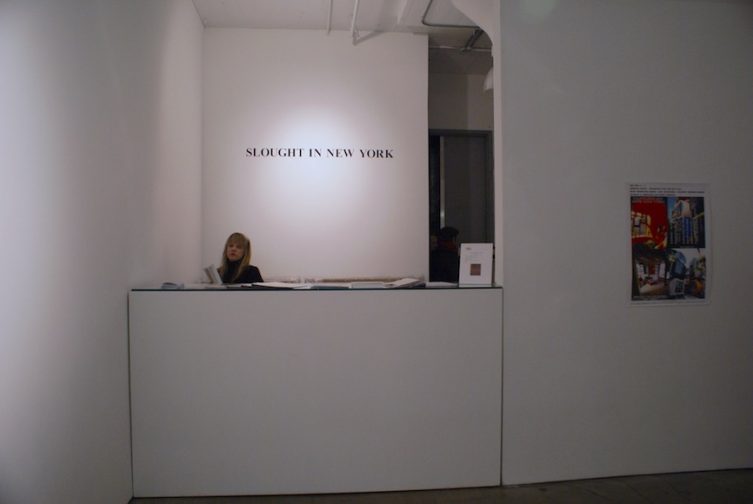CHRISTOPHER HAUN: Empire Line

Solo exhibition by Christopher Haun
Installation view
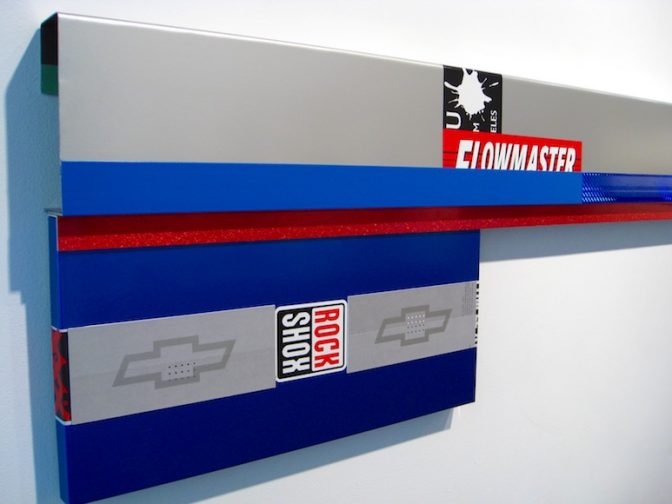
Solo exhibition by Christopher Haun
Installation view

Solo exhibition by Christopher Haun
Installation view

Solo exhibition by Christopher Haun
Installation view

Solo exhibition by Christopher Haun
Installation view

Solo exhibition by Christopher Haun
Installation view

Solo exhibition by Christopher Haun
Installation view

Solo exhibition by Christopher Haun
Installation view

Solo exhibition by Christopher Haun
Installation view

Solo exhibition by Christopher Haun
Installation view
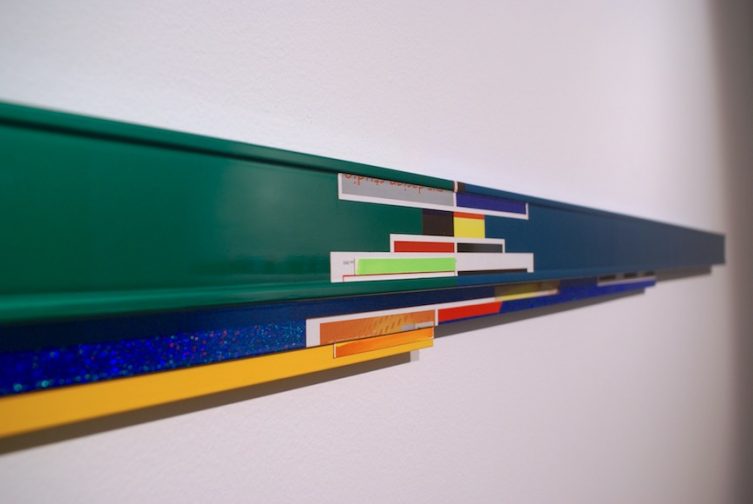
Solo exhibition by Christopher Haun
Installation view

Solo exhibition by Christopher Haun
Installation view

Solo exhibition by Christopher Haun
Installation view

Solo exhibition by Christopher Haun
Installation view
ZONE:Chelsea Center Center for the Arts is delighted to announce a major exhibition of new work by Christopher Haun. This is his first solo exhibition since joining the gallery.
Christopher Haun explores the historically fertile borderline between abstraction and landscape, building on his intimate familiarity with two uniquely American regions, the Hudson River and the California coast. The title of the exhibition, Empire Line, derives from Haun’s recent series based on his commuting experience on Amtrak’s eponymous train service. From his train car, Haun watches the same majestic panorama of a quintessential American landscape that inspired the nation’s first great art movement, the Hudson River School. Haun distills this sense of continuity – the temporal as well as spatial fluidity of the Hudson — in his wide, narrow-format images. Empire Line, AM, West View, 2007abstracts the riverside view, playing a broad band of magenta against the broken rhythm of multitude of rectangles and vertical strips.
Haun’s background as an architectural draftsman is evident in his meticulous craftsmanship, giving Precisionist clarity of Charles Sheeler to a Romantic subject. Haun’s materials and method underscore the complexity of his approach. He has an affinity for Pop Art, most readily seen in his colorful collages that are comprised of a variety of everyday paper materials. He constructs his tightly controlled zips of landscape from collage elements which have strong personal associations — surfing magazines, a testament to his passion for the sport, and gallery invitation cards for artists he admires. In some works, vibrantly colored steel, aluminum and vinyl add to the dialogue between nature and commercialization, a theme explored by the Hudson River School painters as well as Pop Artists.
The landscape genre is intrinsically Romantic, and painterly looseness is often considered part of that paradigm. But Haun’s passion for nature is distilled into precise diagrams of moments in time. Intimations of personal history add subtle layers of meaning to the visually cogent compositions of this elegant draftsman and colorist.
Christopher Haun
Empire Line
October 18 – November 24, 2007
Opening Reception
6-8PM, Thursday October 18, 2007
Christopher Haun explores the historically fertile borderline between abstraction and landscape, building on his intimate familiarity with two uniquely American Regions the Hudson River and the California coast. The title of the exhibition, Empire Line, derives from Haun’s recent series based on his commuting experience on Amtrak’s eponymous train service. The “Empire Line” train travels along the eastern side of the Hudson River where the tracks wind along the riverbank literally at the edge of the water. With its source in the Adirondack Mountains, the Hudson River flows through the rolling hills of upstate New York past bucolic small town America and into the hustling hub of Manhattan.
From his train car, Haun watches the same majestic panorama of a quintessential American landscape that inspired the nation’s first great art movement, the Hudson River School. A two-hour video record of this streaming Whistlerian landscape seen through the train window is on view in the gallery. Haun distills that sense of continuity—the temporal as well as spatial fluidity of the Hudson—in his wide, narrow-format images. Empire Line, AM, West View, 2007abstracts the riverside view, playing a broad band of magenta against the broken rhythm of multitude of rectangles and vertical strips. The streamlined shapes evoke not only the river, but also the design of the train cars, with their ribbons of windows and decorative stripes.
Haun’s background as an architectural draftsman is evident in his meticulous craftsmanship, giving Precisionist clarity of Charles Sheeler to a Romantic subject. Haun’s materials and method underscore the complexity of his approach. He has an affinity for Pop Art, most readily seen in his colorful collages that are comprised of a variety of everyday paper materials. He constructs his tightly controlled zips of landscape from collage elements which have strong personal associations—surfing magazines, a testament to his passion for the sport, and gallery invitation cards for artists he admires. Although shredded and cut into precise geometric forms, vestiges of text survive in these mementos. The sharp rectangles and shapes cut from these materials Haun primarily uses as the colors in his palette. In some works, vibrantly colored steel, aluminum and vinyl add to the dialogue between nature and commercialization, a theme explored by the Hudson River School painters as well as Pop Artists.
Haun investigates the layering of compositional elements in vertical as well as horizontal format. His passion for surfing leads to meditations focusing on how the individual responds to waves as vertical phenomena. He explains: “My body is no longer heavy, but light and buoyant. In the water, I literally experience a great weight being lifted, envisioning a huge burden lifted from spirit.” This is the dynamic at work in Haun’s Spray series, in which triple, overlapping rectangles of blue wave rise into diffuse yellow acrylic skies. More abstract images center on blocks of paint-and-collage in columns of intense, sometimes acidic color. Some of these are oriented vertically while some are arranged horizontally. The play of shape and color suggests Josef Albers, “Homage to the Square,” Pop Art and even a harder-edged Mark Rothko, but Haun’s pictures are also a record of his daily experiences, tastes and interests.
The landscape genre is intrinsically Romantic, and painterly looseness is often considered part of that paradigm. But Haun’s passion for nature is distilled into precise diagrams of moments in time. Intimations of personal history add subtle layers of meaning to the visually cogent compositions of this elegant draftsman and colorist.
Dr. Jennifer Baahng
Surfing waves is like making art. It is a meditation. It is tuning in to the rhythms of the earth, the moon, and the planets. It is beach culture and surf culture, slick and quick, slow and mellow. Returning to oneness, returning to nature is our destiny. In my daily practice, I return to nature. Going to the water’s edge and immersing myself in the womblike body of water that is the ocean, my body is no longer heavy, but light and buoyant. In the water, I literally experience a great weight lifted, envisioning a huge burden lifted from my spirit. Riding the rhythmic pulse of nature, mine is an emotional connection to the wave riding experience. In surfing as in art making, creative carving and slicing are a visceral expression of my spirit and my body. Intuitive and primordial, water is from where we came. We are water. Flowing and ebbing, forever-mutable liquid forms, capable of various forms- gaseous or solid. Moving in fast and slow motion, with opaque and transparent surfaces, with both shallowness and great depth, water is both the elixir of life and a vehicle for calming our spirit.
Christopher Haun
Categories: exhibitions
Protected: PILAR GOUTAS: Parteaguas
FACE: Scanvenging Identity

Valentin Stefanoff & Nina Kovacheva,Wet Contact


Burton Silverman
Study in Black & White

Monique Baumann
Painted Polaroids

Kirsten Justesen

Santiago Cal
Ticks

Silvana Agostoni

Mark Mann
Sadness, Six channel video installation

Monique Baumann

Rainer Judd
Digital C-print in plexiglass



Santiago Cal
Habit

Jean-Manuel Simoes

ZONE: Chelsea Center for the Arts is proud to present FACE: Scavenging Identity, exploring the margins of mainstream portrait genre.
Traditional portraiture is a mix of realism and artifice, public persona and private life, interior and exterior. It entails subtle negotiations between artist and model, even when the two are nominally the same. The international artists in this compact but wide-ranging exhibition take a more unorthodox approach, but they retain the perennial fascination with human nature. They challenge the conventions of the genre using a variety of mediums, including painting, collage, sculpture, photography and video. Today, traditional social structures—once defined by nationality, class and gender—have necessarily given way to more individual and improvisational ways of constructing identity.
Much of the work uncovers layers of meaning by focusing on human skin, from the distended belly of a pregnant woman to the leathery remains of a fetish-draped corpse. Some of the artists explore the physical limits of the body with close-ups so extreme that skin and hair become features in alien landscapes, or present parasitic forms that threaten our autonomy.
Others emphasize theatricality and the rituals of self-presentation, whether in Africa or American subcultures. Some create oneiric installations or provide space for the unleashing of raw emotion and the temporary disarrangement of the public face. They appropriate magazines for pictorial journals that blur the line between autobiography and image-making, or old master images to break them down into color charts. This juxtaposition of works by both established and emerging artists creates an exciting matrix for fresh perspectives on visual anthropology.
FACE: Scavenging Identity
June 21 – August 11, 2007
Opening Reception
6-8PM, Thursday June 21
Artists in exhibition:
Silvana Agostoni
Steven Assael
Monique Baumann
Santiago Cal
Rainer Judd
Kirsten Justesen
Mark Mann
Renaud Muraire
Osvaldo Romberg
Burton Silverman
Jean-Manuel Simoes
Valentin Stefanoff & Nina Kovacheva
Silvana Agostoni
Artist Statement
I have always felt the need to directly engage with the body.
To enthrone, enshroud or reveal it.
To address it’s scale, it’s sexuality, and it’s frailty.
I believe that of all the objects of perception, the human body is the one that has more effect on our sensibility, because it is ours, because it contains us.
The central idea of my work is the attraction and repulsion that is evoked by the human body.
By dissecting, magnifying and dislocating the body, I render it anonymous, strange and explore the issue of identification of the body with the self. My intention is to create an uncanny bodily universe that draws in the viewer, and use the body as a bridge between the images and the spectator. I seek to elicit a reaction from the spectator based on physical recognition.
The “mirror stage” according to the French psychoanalyst Jaques Lacan is the first stage in the formation of identity. Between the age of six and eighteen months the infant experiences his body as fragmented and dispersed. When the child recognizes himself in the mirror, he creates an ideal self-image and creates an imaginary physical control, which he has yet to attain.
The body is marked out as a unified totality, complete and whole.
In contrast to this conception, my work represents the body as a vital chaotic force that is excluded from the false control, unity, identity and perfection of the ‘mirror stage’.
I want to introduce strangeness and unfamiliarity where a mirror image is expected, in order to obscure an anticipated pleasure of ideal reflection.
I seek to reveal both the violence of vision by photographing body parts with a clinical eye and the beauty of the body under a microscopic vision.
The work I am presenting is from two series. One is called Fisonomía: 16 C-prints
all 50 x 50 cm and Topografías: 10 C-Prints 50 x 50 cm and 10 C-prints
120 x 120 cm.
In both bodies of work, the body can be seen as a terrain in which I suggest the simultaneous existence of binary oppositions such as inside/outside, masculine/feminine, I/ otherness.
Silvana Agostoni
Education
1994-1997: Master of Fine Arts in Photography. School of Visual Arts, New York, NY, USA.
1990-1994: BFA in Graphic Design. Universidad Autónoma Metropolitana, Mexico City.
Solo exhibitions
- Esfera, Observatorio XP. Morelia, Michoacán, Mexico.
- Silvana Agostoni, Topografías.Centro de la Imagen, Mexico City.
- Fisonomía. Instituto Michoacano de Cultura, Morelia, Michoacán, Mexico.
- Silvana Agostoni, Physiognomy.White Columns, New York, NY. USA
- Construcciones Corporales. Art Deposit, Mexico City.
- Imágenes Etéreas. Galería de la Imagen. Universidad Autónoma del Estado de Querétaro. Mexico
Group exhibitions
2006
Zonema. Zone-Chelsea Center for the Arts. Nueva York, NY, EUA.
Hit the showers. Other Gallery. Banff Centre for the Arts. Canada
Fesitval Internacional de videoarte e Valencia. Valencia España
2005
The image outside of time. Antimatter Underground Film Festival. Victoria, Canada.
2004
2ª Bienal Nacional de Yucatán. Mérida, Mexico.
La Imagen que extraña al tiempo. Chroma video festival, Guadalajara, México.
Piel de Pieles, Barcelona Arte Contemporáneo, La Santa, Barcelona, Spain.
Creación en Movimiento, Galería Central, Centro Nacional de las Artes, México City.
2003
Creación en Movimiento. Galería Kunsthaus Santa Fe, San Miguel de Allende, Mexico.
El Sentido y los Sentidos, Espacio Cultural, Universidad Iberoamericana, México City.
2002
There is no translation. Prinzz Gallery, Kyoto, Japan.
ARCO 2002. Galería Enrique Guerrero, Madrid, Spain.
Salón Internacional de Arte Digital, Casa de América, Havana, Cuba.
ABC DF Palabras de Ciudad. Museo del Palacio de Bellas Artes. Mexico City.
Muestra 001. Contemporary Art Fair, Galería Enrique Guerrero, Monterrey, Mexico.
Fast Fwd. Galería Enrique Guerrero, Miami, Florida, USA.
2001
Intro. Museo Dell´ Arredo Contemporáneo, Ravenna, Italy.
Arco 2001. Galería Enrique Guerrero, Madrid, Spain.
Momenta, Arte Electrónico, Centro Nacional de las Artes, Mexico City.
Latin American Artist-Photographers from the LUAG Collection, El Museo de Historia, Antropología y Arte,
San Juan, Puerto Rico.
2000
Latin American Artist-Photographers from the LUAG Collection, Museo del Barrio, New York, NY, USA.
VI Salón Bancomer-BVA, Fundación Cultural Bancomer, Mexico City.
Salón CANT V, Jóvenes con FIA, Galería Ateneo, Caracas, Venezuela.
Galería Enrique Guerrero, Feria Internacional de Arte, Caracas, Venezuela
1999
Herejías. Peep Show, Galería del Centro Multimedia, CNA. Mexico City.
10 Mexican Photographers: A select end of the century generation. Dubois Gallery. Pennsylvania, USA.
XVIII Encuentro Nacional de Arte Joven. MUCA, Mexico City.
1998
New Visions: Five Contemporary Mexican Photographers. Houston Center for Photography. Houston, USA.
Foto construcciones, Museo de Arte Contemporáneo Alfredo Zalce, Morelia, Michoacán, Mexico.
New York Digital Salon, Visual Arts Museum, New York, NY, USA.
1997
Salón Digital, Círculo de Bellas Artes. Madrid, Spain.
XVII Encuentro Nacional de Arte Joven, Museo Carrillo Gil. Mexico City.
8a Bienal de Fotografía, Centro de la Imagen, Mexico City..
Grants
2006: Residencia artística (Fotografía) Banff Centre for the Arts y FONCA.
2002-03Young Artist production award (Jóvenes Creadores). FONCA. Mexico.
2000 Cultural project award (Coinversión y Fomento a Proyectos Culturales.) FONCA. Mexico.
1999 Digital imaging residency. Centro Multimedia, CNA. Mexico.
1998 Young Artist production award (Jóvenes Creadores). FONCA. Mexico
1995-97 IPS grant, American Association of University Women, New York, NY, USA.
1995-97 Study abroad grant. FONCA. Mexico
Distinctions
Selected at the 2ª Bienal Nacional de Yucatán. 2004
Selected at the Salón Bancomer, 2000
Selected at the Octava Bienal de fotografía. 1998
Selected at the Encuentro Nacional de Arte Joven 1998
Selected at the Encuentro Nacional de Arte Joven 1997
Teaching experience
2005: Personal vision: Centro de la Imagen, Mexico City.
Conceptual photography. Centro de Las Artes, Monterrey NL., Mexico.
2002: Photography after photography. Centro Multimedia, CNA, Mexico City.
2001: Profesor of photography, seminar. BFA in Visual Arts, UAEM, Mexico.
1999: The digital image . Centro de la Imagen. Mexico City.
1998: Photography in the age of digital reproduction. Centro de la Imagen. Mexico City.
Lectures
2003: Primer Coloquio de Fotografía UAM-X: The photographic image as text.
Universidad Autónoma Metropolitana, Mexico City.
2002: Art and Photography at the Centro de la imagen: Lecture on personal work.
Selected Bibliography
- 52 Mujeres en el Arte Mexicano. Catálogo publicado por SEDESOL y CONACULTA, Mexico, 2005.
- El Arte en México. Catalog published by Financiarte. Mexico. 2004.
- Creación en Movimiento, Jóvenes Creadores. Catalog, CONACULTA-FONCA, Mexico. 2003.
- Segre Erica, The Poetics of Skin. Surface and Inscription in Contemporary Mexican Photography.
Bulletin of Hispanic Studies, Vol 79, no.3. Liverpool University Press. July, 2002.
- ABC DF, Diccionario Gráfico de la Ciudad de México. Diamantina. 2001.
- Luna Córnea, 21/22. Centro de la Imagen-CONACULTA. 2001.
- Silvana Agostoni, catalog published by Galería Enrique Guerrero, Mexico 2000.
- VI Salón de Arte Bancomer. Catalog. Fundación Cultural Bancomer. Mexico, 2000.
- Medina Cuauhtemoc, Ejercicios del no-lugar. Article published in journal Reforma, may 31, 2000.
- Castellanos Alejandro, Al filo del siglo. Panoramas, february, 2001.
- Sepúlveda Luz Maria, El Cuerpo Humano en la Fotografía Actual. Tierra Adentro #105. CONACULTA. Mexico,
- 10 Mexican Photographers. A select end of the century generation. Catalog. Dubois Gallery, PA, USA. 1999
- Rodríguez José Antonio, Por ver no se paga: imágenes olvidadas. El Financiero, Mexico, August 26, 1999.
- Rodríguez José Antonio, Foto Mexicana de entre siglos. Tierra Adentro #100. CONACULTA. Mexico, 1999.
- Rodríguez José Antonio, Octava Bienal: una renovación. El Financiero. México, October 23, 1997.
- Arreola Magalí,Revigorizar la fotografía mexicana. Reforma. Mexico, September 24, 1997
- New York Digital Salon. Catalog. Leonardo: Journal for Art and Sciences. Vol. 30 No. 5. MIT Press. 1997
Steven Assael
Steven Assaelwas born in New York, New York in 1957. He attended Pratt Institute and presently teaches at The School of Visual Arts in New York. Mr. Assael balances naturalism with a romanticism that permeates the figures and surroundings of his paintings and drawings. The focus of his work is the human figure, either individually or in a group, rendered in glowing relief by gentle beams of warm and cool light. Steven Assael’s classical talents are as rare as they are essential to the diverse art world of the late Twentieth Century.
Assael has had several solo shows nationally in recent months, including the Columbus Museum of Art, Cress Gallery of Art at the University of Tennessee, Lowe Gallery in Atlanta, and Forum Gallery in Los Angeles. In 1999, a retrospective one-person exhibition was held at the Frye Art Museum in Seattle, Washington. Steven Assael’s work has also been exhibited at The Arkansas Arts Center, (AR), The New York Academy of Art, (NY), The Arnot Art Museum in (NY) and is represented in the public collections of The Hunter Museum of Art in Chattanooga, (TN), The Kemper Museum of Contemporary Art & Design (MO), The Columbus Museum of Art (Columbus, OH) and the Metropolitan Museum of Art (NY).
http://www.forumgallery.com/adetail.php?id=207
Monique Baumann
Monique Baumann was born in 1959 in Zofingen. After completing foundation courses at art schools in London and Zurich, she studied graphic design at the Lucerne School of Art and Design. Since 1990, she has worked as an independent artist and illustrator. Her work has been published in various international magazines and books and has received numerous awards. In recent years, she has participated in group shows at Palais Lichtenstein, Feldkirch, Austria (2004); Galerie Gruner + Jahr, Hamburg, Germany (2005); and at Palais de Tokyo Hypegallery, Paris, France (2005). Monique Baumann has been living and working in Zurich and Paris since 1995.
Artist Statement
I often use found materials as a starting point for my work. I like to transform something that is already there into something new, engaging in a dialogue with the material and thus creating a new story. This process is a way of engaging with my urban environment and with contemporary reality, an immediate, sensual commentary and reflection on the world around me.
Painted Magazines
For a year I was commissioned to illustrate a column for the weekend supplement of the German newspaper “Sueddeutsche”. Instead of just archiving my specimen copies, I decided to rework each copy into a kind of artist’s book. Each focuses on a theme –a story, a topic that preoccupied me at the time, or a formal experiment. I used and combined a variety of techniques: I was painting and drawing in oil, acrylic, and ink, or I created collages with tape, postcards, photos and so forth. Sometimes I would integrate part of the contents of the magazine, sometimes I covered them entirely with my own work. Whereas the original magazine’s pages are rather thin and fragile, the reworked magazines have entirely different material quality. They are tangible objects, almost a kind of sculpture. Although each issue is self-contained, their entirety constitutes a chronicle of year in my life, reflecting my personal, formal, and intellectual preoccupations.
Polaroid Miniatures
I often take photographs, whether it’s analogue, digital, or Polaroid photographs. I decided to use my discarded Polaroids as a material basis for miniature paintings. Their format was a challenge since it called for a maximum reduction and condensation. The Polaroid Miniatures are mostly portraits. Some are inspired by the photographic image underneath the painting that was both extinguished and transform by it. Others were inspired by my collection of magazine photographs and everyday photography that I reinterpret in my paintings. Once again, I used a variety of styles, adapting my manner of painting to the subject at hand.
Monique Baumann
Santiago Cal
Artist Statement
The human image and its contextual implications have been the primary focus of my sculpture. The threads that run through my works are based on observations from my travels as well as the vastness of children’s dreams. These two work hand in hand, since most of my observations are of children daydreaming, entertaining themselves with meager objects and the Don Quixotesque role-playing. My interest in these activities boils down to the ability of participating in two realities at once; our reality and their conjured reality. This activity may be only a few seconds or a few minutes but in their minds they have tapped into an epic moment, a different scale of time.
I am not interested in illustrating these moments but instead creating scenarios that allude to a narrative, which causes the viewer to create their own conclusions. The elements that act as catalysts for this to occur range from Rorschach like blots to mirrors which serve as invitations for the viewers to become integrated into the piece. In other works I manipulate an ordinary event by shifting the scale of the figures or creating a magical moment by stacking balls that seem to defy gravity. Although the pieces may seem as pleasantly wholesome they also contain elements of dark humor, melancholia and pointed social statements, all contributors to our inner dialogue and subconscious.
-Santiago Cal
Education
1998 M.F.A. – Virginia Commonwealth University. Richmond, VA
1995 B.F.A. – Kutztown University. Kutztown, PA
One Person Exhibitions
2007 just looking. Te Tuhi. Manukau City, New Zealand
2006 dory.Lied Gallery. Creighton University. Omaha, NE
2005 Tierra! Tierra! Sheldon Memorial Art Gallery. Lincoln, NE
2003 new dose. Casa de Las Americas. Havana, Cuba
encounters. Olimpo Centro Cultural. Merida, Mexico
dissemination.Marxhausen Gallery. Concordia University, Seward, NE
electric fences. Capella de Los Remedios. Santo Domingo, Dominican Republic
durable view. Image Factory Art Foundation. Belize City, Belize
2001 milk clouds. Image Factory Art Foundation. Belize City, Belize
Selected Group Exhibitions
2007 Landings6.Centro de Wilfredo Lam. Havana, Cuba
Landings5. Art Museum of the Americas. Washington, DC
Landings4.Museum of Contemporary Art and Design. San Jose, Costa Rica
Bemis at 25.Lied Gallery. Omaha, NE
2006 Landings2.Centro de Artes Visuales. Merida, Mexico
Landings3.Centro Cultural de Eduardo Leon Jimenes. Santiago de Los Caballeros,
Dominican Republic
9thHavana Biennial. Havana, Cuba
We are Belize – 25 Years of Independence 1981–2006. Kaohsiung Fine Art Museum.
Kaohsiung, Taiwan
La Escultura Contemporanea. Jan Weiner Gallery. Kansas City, MO
The Tugboat Show.Sheldon Memorial Art Gallery. Lincoln, NE
We are Belize. Image Factory Art Foundation. Belize City, Belize
5thAnnual All Sculpture Show.Jackson Artworks. Omaha, NE
Botanicals.Eisentrager-Howard Gallery. Lincoln, NE
1stACP Festival. Museo de Arte Moderno. Santo Domingo, Dominican Republic
Tugboat Presents.Elder Gallery. Lincoln, NE
2005 Small Wonders: a return to innocence. Home of Matthew. Lincoln, NE
Latta Pichaz.Image Factory Art Foundation. Belize City, Belize
@10.Image Factory Art Foundation. Belize City, Belize
2004 Nebraska Now.Bemis Center for Contemporary Art. Omaha, NE
Landings- Conkal Arte Conteporaneo. Conkal, Mexico
West by Southwest– Burris Art Gallery. NMHU. Las Vegas, NM
2003 UNL Studio Art Faculty Exhibition. Eisentrager-Howard Gallery. Lincoln, NE
Coleccion de la Fundacion GruberJez – Ex Convento de Conkal. Conkal, Mexico
2002 Zero- Ex Teresa Arte Actual. Mexico City, Mexico
Contemporary Art from Central America Isthmus – Taipei Fine Arts Museum.
Taipei, Taiwan
Zero- Museum of Modern Art. Santo Domingo, Dominican Republic
Zero- Galeria Sala Mendoza. Caracas, Venezuela
Zero- Galeria Sol del Rio. Guatemala City, Guatemala
Zero- Ex Convento de la Compania de Jesus. Antigua, Guatemala
artISMO- Museum of Contemporary Art and Design. San Jose, Costa Rica
ARCO– Galeria Sol del Rio. Madrid, Spain
Zero- Gallery Ze Dos Bois. Lisbon, Portugal
2001 Zero- La Capella. Barcelona, Spain
IV Caribbean Biennial- Museum of Modern Art. Santo Domingo, Dominican Republic
20/XX- Image Factory Art Foundation. Belize City, Belize
Zero- Casa de Las Americas. Havana, Cuba
UNL Studio Art Faculty Exhibition- University of Nebraska. Lincoln, NE
1998 Notorious, New Sculpture. Armory Gallery. Blacksburg, VA
searching for green. Thesis exhibition. Anderson Gallery. Richmond, VA
1997 The Movable Feast. 1708 Gallery. Richmond, VA
Dr. Louis Harris Awards Exhibition. MCV Hospital. Richmond, VA
New Works by New Artists. James Center. Richmond, VA
7thAnnual National Juried Show. Donald Kuspit – Juror. 1708 Gallery. Richmond, VA
Grants and Awards
2007 Nebraska Arts Council Individual Artist Fellowship
2006 Maude Hammond Fling Faculty Research Fellowship. University of Nebraska.
Lincoln, NE
2005 Artist in Residence- Bemis Center of Contemporary Art. Omaha, NE
Research Council Grant in Aid. University of Nebraska – Lincoln
2004 Nebraska Arts Council Individual Artist Fellowship
Hixson-Lied Faculty Research Grant. University of Nebraska- Lincoln
2003 Artist in Residence – Poustinia Land Art Park. Benque Viejo del Carmen, Belize
Hixson-Lied Faculty Seed Grant. University of Nebraska- Lincoln
2002 Artist in Residence – Gruber- Jez Foundation. Cholul, Mexico
Layman Research Grant. University of Nebraska- Lincoln
Research Council Grant. University of Nebraska- Lincoln
2001 Fine and Performing Arts, Dean’s Research Grant. University of Nebraska- Lincoln
Layman Research Grant. University of Nebraska- Lincoln
Humanities Center Summer Research Grant. University of Nebraska- Lincoln
Human Rights and Human Diversity Research Grant. University of Nebraska- Lincoln
Selected Press and Reviews
Umelec Spring 2007. Czech Republic
ArtNexus. No.63. Miami, FL. 2007
ArtWorld Digest. March 2006. Brooklyn, NY
Belize Times. 6//2006 Belize City, Belize
Art Papers. July/August 2005. Atlanta, GA
La Prensa Literaria.11/20.2004. Managua, Nicaragua
Artes Revista Especializada en Arte Caribeno. October/December 2003.
Santo Domingo, Dominican Republic
Gramma International Digital.4/23/2003. Havana, Cuba
Por Esto. 6/19/2003 Merida, Mexico
Art Nexus. No. 46 Miami, Florida
El Caribe. 10/30/02 Santo Domingo, Dominican Republic.
El Nacional. 6/15/02 Caracas, Venezuela
Prensa Libre. 4/8/02 Guatemala City, Guatemala
Atlantica Art Journal. 2/02 Madrid, Spain
ABC.2/18/02. Madrid, Spain
Time Out. 1/02 Barcelona, Spain
Casa de Las Americas Journal. 7/01 Havana, Cuba
El Pais. 12/01 Madrid, Spain
Rainer Judd
Rainer Judd’s photographs of natural landscapes are often perceived as painting until closer examination. As a filmmaker trained in the use of 16mm film her sense of the “grain” of a photo simulates a type of “chiaroscuro” within the image. Judd’s use of low tech equipment and techniques allows her to engage herself in the image capture. Every day places are transformed into abstract components of color and texture. The viewer is challenged to discover the image components while experiencing the visceral spaces and colors of the natural landscapes.
Judd’s watercolors of natural landscapes are made with small and specific brush strokes or “dots” used to define textures, subtle color shifts, numerous trees, grasses, and land; imagery such as an extremely leaning tree or the shadow of an animal gives an emotional quality to the landscape.
Her specific use of technique and imagery choice illuminates a reverence for a time and a place and references a narrative framework in both the imaginary world of her watercolors and the “real” places of her photography.
Filmography
writer and director
Remember Back, Remember When(2007) 9 min super16 director
Marfa Voices, a work in progress(2006) 42 min video co-director
Lost and Found(1992) music video 3 min16mm director
Plague Circuit (1991) 18 min 16mm director
Three Pieces of Real Texas Time(1990) 10 min video director
Waste Generation(1990) 6 min video director
Instant End(1989) 5 min 16mm director
Sprout (1989) 5 min 16mm director
Carmelita’s Reception House (1989) 17 min 16mm segment director
Pantera(1989) 3 min 16mm director
Untitled #1(1989) 3 min16mm director
producer
Marfa Voices, a work in progress(2006) 40 min video producer
Tales of Cerro Chino(1992) 60 min video producer
Foxtrot Romeo Film Festival, Marfa, Texas 1991-1993
actor
The Picture of Dorian Gray(2004)
The Pornographer, A Love Story(2004)
Wake(2003)
Town and Country(2001)
Reunion(2001)
Perfume(2001)
Head Games(2001)
Lost Souls(2000)
End of Days(1999)
The Hi-Line (1999)
Pure Killjoy(1998)
Long Time Since (1997)
Hugo Pool(1997)
Drowning in West(1996)
Jack (1996)
Toughguy(1995)
selected crew
Even Cowgirls get the Blues(1993) set costumer
Betty Carstairs Story(1991) videographer, The Wooster Group
The Fisher King(1991) wardrobe assistant
New York Stories(1989) production assistant, segment “Life Without Zoe”
Anna (1988) production and post assistant, Magnus Films
Lives and works in Hudson and New York City
B.A. film New York University, Tisch School of the Arts 1991
selected exhibitions
2007 CCCA Studio Tours Art in the Landscape, Columbia County, NY
2006 Manhattan TransferZone Chelsea NY, NY
ZC Collection Zone Chelsea NY, NY
2004 Manhattan Transfer Chatham, NY
Shout! Time and Space Limited, Hudson, NY
2003 101 Spring St.,Zing Magazine curated by Madeleine Hoffmann
2001 Silverlake Silverlining, Los Angeles, CA
Show, Pageant, Los Angeles, CA
awards
2007 Art Production Fund, Artists at Giverny Residency and Grant
1991 Texas Award at Dallas Video Festival for Plague Circuit (1991)
panels and discussions
2007 Judd Foundation: Oral History for Artist’s Legacies, a panel discussion.
2007 New York Foundation for the Arts: Artist’s Forum
2006 Zone Chelsea, John Weber’s Columbia County Artists discussion
press
Inside Out Hudson valley, January/February 2007
W Magazine, November 2006
Berkshire Living, February/March 2005
brilliant magazine, October 2004
Upstate House, October 2004
Interview Magazine, February 1992
selected collections
Arne Glimcher
Marc Glimcher
Jaime Frankfurt
John Howard
Jean Gabriel Mitterand
Carol Taylor
Kristen Justesen
Kirsten Justesen *1943. Lives and works in Copenhagen.
Educated at the Royal Academy of Fine Arts 1975. Cand.phil 1977.
A series of exhibitions, events, installations, performances and mural work in Denmark and the rest of world since the mid-60s.
Visiting professor and lecturer at art academies in Scandinavia, the USA and the Middle East.
Scenographic work at a number of Danish theatres since 1967; established the Scenography Department at the Danish National Theatre School in 1985-1990.
Important co-operations in the 90s include concept and set design for Randi Patterson Company.
Curated Body as Membrane together with VALIE EXPORT at Kunsthallen Brandts Klædefabrik 1995
Justesen has received a series of grants, including the Anne Marie Telmanyi Award 1991; The Eckersberg Medal 1996; Life grants from The Danish Art Foundation 1998; The Carl Nielsen & Anne Marie Carl-Nielsen Award 2000; The Anna Nordlander Award 2003;The Thorvalsen Medal 2005 and a ISCP residency, New York 2006.
Justesen has illustrated books, magazines, designed posters and a series of chasubles for Capernaum Church in Copenhagen.
KORS DRAG was published 1999 at Brøndum.
Represented in private and public collections, including Statens Museum for Kunst; The Dep. of Prints and Drawings; Museum of Modern and Contemporary Art, Aalborg; the New Carlsberg Foundation; Køge Art Museum of Sketches; Museum of International Ceramic Art of Denmark; The Art Museum Brundlund Castle; Museum Anna Nordlander, Sweden.
Member of the Artist Society and the Academy of Fine Arts.
Member of the board of The Odin Theatre, Holstebro and Kaleidoskop, Copenhagen.
Kirsten Justesen’s activities comprise a wide range of genres, from body art and performance art to sculptures and installation. Justesen was part of the avant-garde scene of the 1960s, where she became a pioneering figure within the three-dimensional modes of art that incorporate the artist’s own body as artistic material. These experiments led her in the direction of the so-called feminist art which challenged traditional value systems during the 1970s. Her later works constitute broader investigations of relationships between body, space, and language.
Reviews:
http://findarticles.com/p/articles/mi_m1248/is_n11_v82/ai_15918949
Kirsten Justesen *1943. Lives and works in Copenhagen.
Educated at the Royal Academy of Fine Arts 1975. Cand.phil 1977.
A series of exhibitions, events, installations, performances and mural work in Denmark and the rest of world since the mid-60s.
Visiting professor and lecturer at art academies in Scandinavia, the USA and the Middle East.
Scenographic work at a number of Danish theatres since 1967; established the Scenography Department at the Danish National Theatre School in 1985-1990.
Important co-operations in the 90s include concept and set design for Randi Patterson Company.
Curated Body as Membrane together with VALIE EXPORT at Kunsthallen Brandts Klædefabrik 1995
Justesen has received a series of grants, including the Anne Marie Telmanyi Award 1991; The Eckersberg Medal 1996; Life grants from The Danish Art Foundation 1998; The Carl Nielsen & Anne Marie Carl-Nielsen Award 2000; The Anna Nordlander Award 2003;The Thorvalsen Medal 2005 and a ISCP residency, New York 2006.
Justesen has illustrated books, magazines, designed posters and a series of chasubles for Capernaum Church in Copenhagen.
KORS DRAG was published 1999 at Brøndum.
Represented in private and public collections, including Statens Museum for Kunst; The Dep. of Prints and Drawings; Museum of Modern and Contemporary Art, Aalborg; the New Carlsberg Foundation; Køge Art Museum of Sketches; Museum of International Ceramic Art of Denmark; The Art Museum Brundlund Castle; Museum Anna Nordlander, Sweden.
Member of the Artist Society and the Academy of Fine Arts.
Member of the board of The Odin Theatre, Holstebro and Kaleidoskop, Copenhagen.
Kirsten Justesen’s activities comprise a wide range of genres, from body art and performance art to sculptures and installation. Justesen was part of the avant-garde scene of the 1960s, where she became a pioneering figure within the three-dimensional modes of art that incorporate the artist’s own body as artistic material. These experiments led her in the direction of the so-called feminist art which challenged traditional value systems during the 1970s. Her later works constitute broader investigations of relationships between body, space, and language.
Mark Mann
Artist Statement
In struggling to maintain control over the situations of our lives, we fight to distinguish ourselves. But it is in the sad vulnerable moments, when we are completely overwhelmed, that we can’t help but be just like everyone else. SADNESS is a simple expression of emotion. In release there is relief.
Mark Mann
Mark Mann is a director, producer, editor and visual artist living and working in downtown Manhattan. He has worked on projects for The United Nations, The United States Postal Service, Harper’s Magazine, MTV, and Missy Eliot, as well as numerous public relations firms, web-based companies, garage bands and production companies. His first short film, ‘Sangam’, plays weekly on the Sundance Channel and his most recent short, ‘Making a Living’, has been showcased in festivals across the country and abroad. He is currently directing a feature length documentary about two people who have been trying to finish their first film for almost 40 years. He has designed art installations that have shown in museums and festivals in Copenhagen, Paris, Barcelona, Croatia, Swaziland, San Francisco, Manhattan and Brooklyn.
Select Projects
Corporate
Sachs Insights….editor Corporate presentations for Nokia, Nissan, Best Buy and others
United States Postal Service ….dv shooter Nationwide interviews with small business owners about how the USPS has been integral to the growth of their businesses
The United Nations ….director/designer Documentary-style dvd fundraising package, designed to raise money for Humanitarian Relief in the Democratic Republic of the Congo
Harper’s Magazine ….director/designer Corporate pitch films, Targeted audience dvd packages, Publicity reels
Missy Eliot ….producer/editor Video-Wall backdrop for her concert in Madison Square Garden
MTV ….editor
Sonicnet.com tv commercial campaign
Disney ….director/designer
Various media and promotional packages
HBO ….producer
Dennis Miller Show promo commercial
ENK International ….director/designer Documentary style fashion shoots, DVD presentation packs, Runway shows, Archival footage, Trade show displaysa
New York Institute of Photography….dv shooter
Series of educational videos on photographic technique
Holy Cross College ….director/designer
DVD fundraising package
Film
Finding Heaven ….directorFeature-length doc in progress about two ageing hipsters who have been trying to finish their first film for almost 40 years, a film Martin Scorsese produced starring a bunch of Warhol Superstars
Making A Living ….writer/director/editora darkly intimate short film about the getting ready rituals of two damaged girls trying to make the best of the abusive patterns that rule their lives, and the guy who’s trying to make sense of them through the lens of his video camera – as they all deal with the inevitability of doing what they have to do to survive
Sangam ….producer/editor Official Selection, Sundance Film Festival 2004, short film category This short film is a meditation on the longing of the human spirit, focusing on a chance meeting between two men on a subway
Ashtanga, NYC ….dv shooter Official Selection, Tribeca Film Festival 2003, documentary category This documentary focuses on yoga in Manhattan during the chaos of 9/11, including interviews with Gwyneth Paltrow and Willem Dafoe
Art Installation
Sadness ….director/designer A multi-monitor video installation featuring 19 crying people Premiered in Brooklyn, New York
Bubbles ….director/designer A multi-monitor video installation featuring people chewing gum and blowing bubbles Premiered in Manhattan, New York
Eunuchs ….designer A multi-wall video installation concerning a tribe of eunuchs in India Premiered in Copenhagen, Denmark
Child Prostitution ….designerA multi-wall video installation concerning child prostitution in India Premiered in Barcelona, Spain
Renaud Muraire
Born in 1972 in Nice, France
Lives and works in Paris.
Renaud Muraire portrays modern day women, particularly within their intimacy.
Responding to media’s current codes, he uses representation of beauty and youth to question self-awareness, appearance and society’s demand.
Beyond contemporary preoccupations, beauty thereby embodies something inexplicable: gazes are sharp and flesh is marked, as scars being part of identity. This theatricality of appearance brings us closer to the subjects: spectator becomes voyeur, and privacy leads to a public scene. Closeness then merges with guilt of intrusion.
Renaud Muraire’s subjects often express vulnerability mixed with strength and power, which manifests something of our very contemporary age. The shown and expected perfection cannot hide internal feelings. These women seem to be imprisoned behind impossible physical diktats, using their beauty as a lead shield. Renaud Muraire is too haunted by the question of time. His subjects can be regarded as witnesses of external mutation, and the intimate reaction to this change. The consciousness of transience adds a very specific intensity to Renaud Muraire’s work. Through embezzling religious stereotypes (Icons Series), Renaud Muraire then places woman above human, allegory for her central position in today’s society.
Previous exhibitions:
- Private solo exhibition, September 2005, Paris
- Group exhibition, June 9th– July 14, 2006, Cologne (Germany), 3 sites (Gallery Seippel, Heinz Bossert Gallery and French Institute)
Osvaldo Romberg
Born in Buenos Aires, Argentina
Lives and Works in New York, Philadelphia and Isla Grande, Brazil
Selected Individual Exhibitions
Jesus de Buenos Aires,
Kunst Museum, Bonn
Buildings Footprints,
Museum of Modern Art Buenos Aires, Buenos Aires
Framing the Art,
Heike Curtze Gallery, Vienna
The War of the Jews
The Artist Workshop, Tel – Aviv
The Library is Burning
The University of Pennsylvania Library, Philadelphia
2005 Translocations: Architectural Installations, 1980 – 2005, (cat.), PeKA Gallery for Experimental Art and Architecture, Technion, Haifa
Narrative Architectural (1987—2005), (cat.), Musée d’Art Moderne de
Saint Etienne, Saint Etienne
Text, Image, Object (1963 – 2005), (cat.), Van Abbemuseum, Eindhoven
Dear Theo…(the night Van Gogh cried), Galerie Heike Curtze, Berlin
2004 From Paradise to Paradise: A Hypertext about Love in Three Parts,
Julie M. Gallery, Tel Aviv, Israel
2003 From Paradise to Paradise: A Hypertext about Love in Three Parts, Universal Concepts Unlimited, New York
2001 The Library Is Burning (recent books), Jan Van der Donk Gallery, New York
2000 Besame Mucho: A Hypertext About Love (cat.), Domgrabungsmuseum, Salzburg, Austria, and White Box Gallery New York
Retinal-Non-Retinal (cat.), Staedtische Kunstsammlungen, Augsburg
1999 Romberg´s Walks at the Kunsthistorische Museum(cat.), Kunsthistorische Museum, Vienna and Galerie Heike Curtze, Vienna
- Bypass(1972-1997) (cat.), Kunstmuseum, Bonn;
Galerie Hohenthal & Bergen, Munich;
Osvaldo Romberg: A Survey (1974-1997), Stux Gallery, New York
1996 +2000/-2000 Even(cat.), exhibited simultaneously at:
Fundacion Xavier Corbero, Barcelona;
Ludwig Museum, Budapest;
Ludwig Museum, Cologne;
Museum of Modern Art, Odessa;
Pennsylvania Academy of the Fine Arts, Philadelphia;
The Reykjavik Municipal Art Museum, Reykjavik;
Stadtgalerie, Saarbruecken;
Tel Aviv University Gallery, Central Library;
Sudo Museum, Tokyo;
Museum Moderner Kunst, Vienna.
1995 Artist Space, New York: The Return of Martin Steel(prospect)
Galerie Hohenthal & Bergen, Cologne: New Books and Short Stories
1994 Gimel Gallery, Jerusalem: Re-Citing, Books and Short Stories
1993 Museum Moderner Kunst, Vienna: Building Footprints III(cat.)
Sprengel Museum, Hannover: On Scale (cat.)
Fundacion San Telmo, Buenos Aires: La vie en Valise: The Artist as Curator(cat.)
Galerie Heike Curtze, Vienna: New Works
Galerie Schueppenhauer, Cologne: New Works
1992 Galerie Montaigne, Paris: Romberg: The ’70s, the ’80s
1991 The Israel Museum, Jerusalem: Building Footprints(cat.)
MUHKA-Museum of Contemporary Art, Antwerp: Building Footprints II(cat.)
Wilhelm Lehmbruck Museum, Duisburg: On Scale(cat.)
1990 The Jewish Museum, New York: Installations(cat.)
1988 Galeria Julia Lublin, Buenos Aires: Prepictum, Postpictum + Working Drawings(cat.)
1987 Galeria Paolo Figueredo, Sao Paulo (cat.)
1986 Museo de Arte de Sao Paulo: Hybrid Objects and Installations(cat.)
1985 Tibor de Nagy, New York (cat.)
1984 XLI Venice Biennial, Israel Pavilion: Retrospective 1972-1984 (cat.)
Utrecht Museum of Contemporary Art, Netherlands: Drawings(cat.)
Kunstmuseum, Hannover: Osvaldo Romberg und der Merzbau von Kurt Schwitters (cat.)
Galerie Springer, Berlin:From Analysis to Metaphor
1983 Galerie Stadler, Paris
1982 Bauhaus-Archiv-Museum. Berlin: Color Environment
Musee D’Art Moderne, Strasbourg: Mythologies, From Altamira to Manet, An Emotional Analysis of Art History(cat.)
Neue Galerie, Sammlung Ludwig, Aachen: Mythologies, From Altamira to Manet, An Emotional Analysis of Art History (cat.)
1981 Museum des 20. Jahrhunderts, Vienna: Mythologies, From Altamira to Manet, An Emotional Analysis of Art History (cat.)
1980 Tel Aviv Museum, Tel Aviv: Mythologies, From Altamira to Manet, An Emotional Analysis of Art History(cat.)
1979 Galerie Stadler, Paris
1978 Galerie Peccolo, Livorno: Works on Paper
1975 International Cultural Center, Antwerp: Typologies(cat.)
1974 Institute of Contemporary Art, London: Projects
1972 Center of Art and Communication, Buenos Aires: Landscape as Idea (cat.)
Selected Group Exhibitions
2005 Domicile: Privé/Public, installations of “Syzygy III” and “The Last
Machu Pichu”, Musée d’Art Moderne de Saint Etienne, Saint Etienne
2000 Topologies: Weiner, Le Va, Anastasi, Romberg, White Box Gallery, New York
1999 Faith,The Aldrich Museum of Contemporary Art, Connecticut
Plural Speech, White Box Gallery, New York
1998 Tel Aviv Museum: The Seventies
1997 Unmapping the Earth, Kwangju Biennial, Korea.
Transversions,Second Biennial of Johannesburg, South Africa
1995 Venice Biennial: Avant-Garde Walk a Venezia
Artists’ Museum, Mitzpeh Ramon, Israel: White Machu Pichu
1993 Thread Waxing Space, New York: Les Levine, Osvaldo Romberg, Nancy Spero
Museum of Contemporary Art, Wright State University, Ohio: Quotations
1992 Aldrich Museum of Contemporary Art, Ridgefield, Connecticut: Quotations
1991 Helena Rubinstein Pavilion, Tel Aviv Museum of Art: Perspective
1989 Aldrich Museum of Contemporary Art, Ridgefield, Connecticut:Projects, Installations
1985 Kenynklist, Museum voor Schone Kunsten, Antwerp:Kunst in Israel
Wilhelm Hack Museum, Ludwigshafen:Apokalypse
18th Biennial: Sao Paulo:Artistas Convidados
1984 Sprengel Museum, Hanover:Nackt in der Kunst
XLI Venice Biennial:Arte allo Specchio
Kunsthalle, Berlin:Rationalism
1983 Neue Pinakothek, Munich:Three Artists about Monet
1976 Lousiana Museum, Copenhagen:Latin American Art
Curatorial Work
2005 Hermann Nitsch / Die Aktionen: 1962-2003, Slought
Foundation, Philadelphia
Cielito Lindo, Work by Julio Grinblatt, Slought Foundation,
Philadelphia
Co-Curator,Non-Retinal: Kovert Konflagration Kovenant,
Slought Foundation, Philadelphia
2004 The Other Epistemology, Museum of Reproductions, Slought
Foundation, Philadelphia
Me altar’s egoes:An Exhibtion of William Anastasi,
Slought Foundation, Philadelphia
Terror: A Collaboration between an Israeli and a Palestinian,
Slought Foundation, Philadelphia
2003 A Tribute to Coltrane, Co-Curated exhibition, Slought Foundation,
Philadelphia
Unconventional Three-Dimensional, Slought Foundation, Philadelphia
2001 First Blood, Ericson Gallery, Philadelphia
2000 Co-curator, Faith: the impact of religion on contemporary art, Aldrich Museum of Contemporary Art, Ridgefield, Connecticut
1999 Unquiet Urbanism, White Box Gallery, New York
1997 Narrative Sculpture, White Box Gallery, Philadelphia
1991 Paper As Knowledge, Dueren Biennial, Leopold-Hoesch-Museum, Dueren, Germany
Publications
Romberg, Osvaldo, The Inverted Pyramid, Text for the Paper Biennial of Dueren, Germany, 1991
Romberg, Osvaldo, Unquiet Urbanism, exhibition catalog, White Box Gallery, New York, 1999
Romberg, Osvaldo, Art to Art. Life to Life.From “Faith” exhibition catalog, Aldrich Museum of Contemporary Art, 2001
Romberg, Osvaldo, Hidden Texts, From “+2000/-2000, Even” exhibition catalog, 2001
Romberg, Osvaldo, Stupid Like a Painter, Text for Of the Diagram: The Work of Marjorie Welish, Slought Books, Philadelphia, 2003
Romberg, Osvaldo, Unconventional Three-Dimensional, Text for Unconventional Three-Dimensional exhibition, Slought Foundation, Philadelphia, September 2003
Romberg, Osvaldo, Text for Me altar’s egoes:An Exhibtion of William Anastasi, Slought Foundation, Philadelphia, 2004
Romberg, Osvaldo, Text for The Other Epistemology, Museum of Reproductions, Slought Foundation, Philadelphia, 2004
Romberg, Osvaldo, Redemption through Blood: Hermann Nitsch’s Theatre of Orgies and Mysteries, Text for Hermann Nitsch / Die Aktionen: 1962-2003, Slought Foundation, Philadelphia, 2005
Romberg, Osvaldo, Evolution, Revolution, and Cielito Lindo, Text for Cielito Lindo, Work by Julio Grinblatt, Slought Foundation, Philadelphia, 2005
Prizes
1967 Gran Premio de Honor Cordoba, Argentina
1968 Gran Premio Nacional Argentina
1974 Premio Benson & Hedges, Argentina
1992 Prize Sandberg, Jerusalem
2004 Heilman Artist and Lecturer, Swarthmore College, PA
Works in Permanent Collections
MUHKA-Museum of Contemporary Art, Antwerp
Kunstmuseum, Bonn
Museo de Bellas Artes, Buenos Aires
Ludwig Museum, Cologne
Leopold-Hoesch Museum, Dueren
Wilhelm Lehmbruck Museum, Duisburg
The Haifa Museum, Haifa
Sprengel Museum, Hannover
The Israel Museum, Jerusalem
California State University, University Library, Long Beach
Wilhelm Hack Museum, Ludwigshafen
Jewish Museum, New York
Museum of Modern Art, New York
Philadelphia Art Museum, Philadelphia
The Tel Aviv Museum, Tel Aviv
Museum Moderner Kunst, Vienna
Library of Congress, Washington, DC
Burton Silverman
BORN: 1928, Brooklyn, NY
EDUCATION: BA, Columbia University, NY
SELECTED SOLO EXHIBITONS:
2004 Gallery Henoch, New York, NY
2003 RL Foster Gallery, Denver, CO
2001 Total Arts Gallery, Taos, NY
2001 Gallery Henoch, New York, NY
1999 Butler Institute of American Art, Youngstown, OH
& Brigham Young Museum of Art, Provo, UT
1998 Merrill Gallery, Denver, CO
1997 Gerold Wunderlich & Co., New York, NY
1996 The Merrill Gallery, Denver, CO
1996 Gerold Wunderlich & Co., New York, NY
1993 Joseph Keiffer Gallery, New York, NY
1991 Capricorn Galleries, Bethesda, MD
1990 Cudahy’s Gallery, New York, NY
SELECTED GROUP EXHIBITIONS:
2006 The Outwin Boochever Portrait Competition Exhibition, Smithsonian National Portrait Gallery, Washington, DC
2006 Gallery Henoch, New York, NY
2005 Teachers from the Art Students League, Daniel Greene, Burton Silverman, & Sharon Sprung, Gallery Henoch, New York, NY
2005 Art of the 20th Century, New York, NY
2005 USArtists, Philadelphia, PA
2005 San Francisco Int’l Art Expo, CA
2005 Art Chicago in the Park, IL
2005 MA Doran Gallery, Tulsa, OK
2004 US Artists, Philadelphia, PA
2004 Art of the 20th Century, New York, NY
2004Doran Gallery, Tulsa, OK
2004 Gallery Henoch, New York, NY
2004 Delaware Art Museum, Wilmington, DE
2004 National Academy Museum, New York, NY
2003 Art of the 20th Century, New York, NY
2003 US Artists, Philadelphia, PA
2003 Gallery Henoch, New York, NY
2003 National Academy of Design, New York, NY
2002 Gallery Henoch, New York, NY
2001 National Academy of Design, New York, NY
2000 Gallery Henoch, New York, NY
1999 Gallery Henoch, New York, NY
1999 Susan Conway Gallery, Washington, DC
1999 Total Arts Gallery, Taos, NM
1999 Colorado History Museum, Denver, CO
1999 Van Vechten-Linberry Art Museum, Taos, NM
1959-99 National Academy of Design, New York, NY
1979-99 American Watercolor Society, New York, NY
1997 The Ogunquit Museum, Ogunquit, ME
1994 The South Bend Regional Museum, South Bend, IN
PUBLIC COLLECTIONS:
The Anchorage Museum of Art and History, Anchorage, AK
Brigham Young Museum of Art, Provo, UT
The Brooklyn Museum, Brooklyn, NY
The Butler Institute of American Art, Youngstown, OH
Cornell University, Ithaca, NY
The Delaware Museum, Wilmington, DE
Denver Art Museum, CO
The Dillard Collection, University of North Carolina, NC
Hofstra Museum, Hempstead, NY
The Mint Museum, Charlotte, NC
The National Museum of American Art, Smithsonian Institution,
Washington, DC
The National Portrait Gallery, Smithsonian Institution, Washington, DC
The New Britain Museum of American Art, New Britain, CT
The Ogunquit Museum of American Art, Ogunguit, ME
The Parrish Museum of Art, Southampton, NY
The Philadelphia Museum of Art, Philadelphia, PA
The Portsmouth Museum, Portsmouth, VA
The Queensboro Community College Art Gallery, NY
The Rutgers University Museum, Camden, NJ
University of Utah, Salt Lake City, UT
AWARDS AND HONORS:
2006 Jury’s Selection, The Outwin Boochever Portrait Competition, Smithsonian National Portrait Gallery, Washington, DC
2005 Newington Cropsey Cultural Center Award for Excellence in the Arts, New York, NY
2004 Gold Medal, Portrait Society of America
2003 Members Award, Oil Painters of America, Taos, NM
2002 Honorary Doctorate, Academy of Art College, San Francisco, CA
2002 Dong Kingman Memorial Award,
American Watercolor Society Annual
1998 Saunders Waterford Award
1998 The American Watercolor Society Annual, New York, NY
1997 Paul and Margaret Berkelson Prize,
National Academy of Design, New York, NY
1997 Mario Cooper Award,
The American Watercolor Society Annual, New York, NY
1996 Clara Stroud Memorial, The AWS Annual, New York, NY
1992 The Joseph Isidor Medal, NAD Annual, New York, NY
1991 The High Winds Medal, AWS Annual, New York, NY
1991 Smith Distinguished Visiting Professor,
George Washington U., Washington, DC;
1991 Elected Hall of Fame, Pastel Society of America
1990 The Catherine Stroud Memorial Award,
AWS Annual, New York, NY
POSITIONS:
2003-05 Membership Committeer; National Academy of Design
2001-03 Assistant Treasurer; National Academy of Design
1999-01 Member of the Council; National Academy of Design
1992-94 Member of the Council; American Watercolors Society
1976-78 Member of the Council; National Academy of Design
Jean-Manuel Simoes
I was born in 1964, in the suburbs of Paris, France.
From that situation, I got two citizenships French and Portuguese, from my parents and from my birthplace.
After graduating in business and administration I spent few years working in management and trading. I quit on my early thirties.
In 1998, I started a career in photography.
I have been working with major french and western newspapers and magazines (Le Monde, Le Monde 2, Paris Match, Wall Street Journal, Le Figaro, O Expresso, Le journal du Dimanche, Le Figaro Magazine, Focus, L’Express, Télérama, Time Magazine…).
I am represented in France by Editing Agency (Paris), and USA by WpN (New-York).
2007, « Sarkozy, Three years of Photography » at « Visa pour l’Image » Perpignan, France
2007, Nominated Kodal PhotoJournalist
2007, Exhibition Photo 4 Gallery, Paris
2006, « Sarkozy » was nominated at the AFP-Bendrihem price.
2006, « 36,4 » nominated at the AIDDA Paris price.
2006, « Par la fenêtre », nominated at the Kodak Paysage-Architecture price.
2005, « 36,4 » a work on the Paris ringroad was awarded « Prix Spécial du Jury » at the Festival du Scoop d’Angers.
2002, Rwanda nominated at Prix Bayeux war correspondant.
2000, Burundi nominated at Prix Bayeux war correspondant.
Valentin Stefanoff & Nina
Always very minimal with few images, without big special effects, often without text, with a very estimate sound, the common works of Nina Kovacheva and Valentin Stefanoff (mainly video and sonic installation) drive the spectators to pose himself a basic questions about existence in the contemporary world. Many of their recent video installations are intended to the façades of different museums and public buildings. For the video installation “In the Out” which is in the same principle they was awarded a “The 2002 UNESCO Prize for the Promotion of the Arts”.
VALENTIN STEFANOFF
Born: 1959, Sofia, Bulgaria. Lives and works in Paris, France
National Academy of Fine Arts, Sofia. Graduated in 1985
Selected Solo Exhibitions:
2006 -Play for Two Hands and Black, , video installation on the façade of the National Academiy of Fine Arts, Sofia, Bulgaria
-Phases of Accumulation and Extraction in a Limited Space, Musée d’Art Modern et Contemporain, Strasbourg, France
2005 – Au-delà de ce qui est visible, curator Ruxanra Balaci, MNAC, Bucharest, Romunia
– Phases of Accumulation and Extraction in a Limited Space, National Art Gallery, Sofia, Bulgaria
2004 – Au delà de ce Qui est Visible, public project, Paris, France
2003- Currency, Gallery Mabel Semmler, Paris, France
2002 -Experimental Intermedia Galerie, Gent, Belgium
2000- Open – Closed, The Museum of Contemporary Art, Belgrad, Serbia & Montenegro
1999- Identifications of The Space II, Gallery Luc Queyrel, Paris
1997- Day-Box – exhibition “Anonymous” , ATA Centre for Contemporary Art, Sofia
1996- Methods for Self Educations, Galerie de C.I. A. and Galerie de l’Espace Hérault, Paris
1994- 6 x 4 x 16″- Gallery Bernard Jordan, Paris
– Gallery “Graficki Kolektiv, Belgrad, Serbia & Montenegro
– Cultural Centre “Wittgenstein”, Vienna, Austria
1993- 6 x 4 x 16 – Institut Français, Sofia, Bulgaria
1991- Musée des Beaux Arts, Le Locle, Switzerland
1989- Gallery Dogenzaka, Tokyo, Japon
Selected Group Exhibitions:
2006 – -Sometimes the Close is More Open Than Open and Open is More Closed Than Closed, commissaire Karine Vonna,Villa du Parc Centre d’Art Contemporain, France
2005 – Two Asias, Two Europes, curator Gu Zhenqing Shanghai Duolun Museum of Modern Art, China
2004 -Au delà de ce qui est Visible, video installation, Nuit Blanche, Paris, France
-“3.39%”, Macedonian Museum of Contemporary Art, curator Magda Carneci/Maria Vassileva, Thessalonique, Grèce
2003 -Wet Contact, Nuit Blanche, Musée du Montparnasse, Paris, France
– Return Nature II, curator Gu ZhecunqingNanjingShenghuaArts Center, China
-16ès Instants Vidéo de Manosque, Manosque, France
– Video & Digital Art Festival, Novi Sad, Serbia
– One, Several, Many Odyssey – video installation, The Museum of Cinema, Thessalonique, Greece
– Media Art Festival, curator Matrina Grzinic, Maribor, Slovenia
– Export -Import, curator Maria Vassileva, Municipale Gallery – Sofia , Bulgaria
2002- Crossing Time international, Dartington Gallery, Dartington College of Arts, England
– In The Out, 4thBiennial of Cetinje, Curators Iara Boubnova & Andrei Erofeev, Montenegro
– Wet Contact, Kunsthalle Faust, Hannover, Germany
– Mirror of the Balkans, Face -Identity, curator Zoran Eric, National Gallery – Museu, Kraljevu
-Xth Festival Inner Space Multimedia Art «Sound and Image», Poznan
2000 – International Art Forum for Video and New Media, Sofia, Bulgaria
1999- Stocholm Art Fair – Gallery Luc Queyrel
1997 – SAGA-FIAC Edition, Stand Atelier Tanguy Garric, Paris
– Intergrafia ‘97-World Award Winner Gallery, Katowice, Poland
1996 – Seoul Art Fair’96, Stand Tanguy Garric, Seaul, Korea
1995 – The Message of The Sign-Between Letter and Image, Prague-Cracow
1994 – N Forms, Reconstructions and Interpretations- Soros Foundation, Sofia
1993 -XXth International Biennale of Graphic Art, Ljubljana, Slovenia
1992- Chefs d’œuvres de l’estampe du XXème siecle-De Bonnard à Baselitz, The French National Library
1991- Triennial of The Contemporary Arts, New Delhi, India –
1989- L’Europe des Graveurs, Grenoble, France
Prizes and Grants:
2002 – The 2002 UNESCO Prize for The Promotion of The Arts, Paris, France
– Pollock-Krasner Foundation, New York, USA Annual Grant 2002
1995 – Pollock-Krasner Foundation, New York, USA Annual Grant 1995
Nina Kovacheva
Born:Sofia, Bulgaria, lives and works in Paris, France
Schools:National Academy of Fine Arts, Sofia, Bulgaria. Graduated in 1985
One person shoxws (selection):
2006 -Play for Two Hands and Black, video installation on the façade of the National Academiy of Fine Arts, Sofia, Bulgaria
– Phases of Accumulation and Extraction in a Limited Space, Musée d’Art Modern et Contemporain, Strasbourg, France
2005-Au-delà de ce qui est visible”, curator Ruxanra Balaci, MNAC, Bucharest, Romunia
-Phases of Accumulation and Extraction in a Limited Space, National Art Gallery, Sofia, Bulgaria
2004 – Au-delà de ce qui est Visible, outdoor installation, Paris, France
-Vidéo Retrospectif, curator Karine Vonna, Maillon – Wacken, Strasbourg, France
2003 – Currency, Gallery Mabel Semmler, Paris, France
2002 –Wet Contact, Experimental Intermedia Gallery, Gent, Belgium
2001- Approche, Gallery Luc Queyrel, Paris, France
-Approche, Galerie Haos, Belgrade, Serbia
1998 – Sometimes… – Gallery Luc Queyrel, Paris, France
Group shows (selection):
2006-Important Announcement, curator Maria Vassileva, Galerie Municipale d’Art, Sofia, Bulgaria
-Voiler/Dévoiler, curator Karine Vonna, Villa de Parc, Contemporary Art Center, Annemasse, France
-I am the Best, Les petits délices, curator Brent Klinkum, Caen
– 28e Festival International, Films de Femmes, Maison des Arts, Créteil Val de Marne
2005 – Two Asias, Two Europes, curator Gu Zhenqing, Duolun MOMA, Shanghai, China
2004 – Au-delà de ce qui est Visible,Nuit Blanche, Paris France
-0.039225, Cosmopolis, curator Magda Carneci Macedonian Museum of Modern Art, Thessaloniki, Greece
– Falutriennalen , Dalanas Museum, Falun, Sweeden
2003- Return Nature II, NanjingShenghuaArts Center, curator Gu ZhenqingChina
-Wet Contact, Nuit Blanche, Musée du Montparnasse, Paris, France
-One, Several, Many Odyssey, video installation, The Museum of Cinema, Thessalonique, Greece
-16ès Instants Video de Manosque, Manosque, France
-Export -Import, curator Maria Vassileva, Municipale Art Gallery – Sofia, Bulgaria
-9thInternational Festival of Computer Arts, curator Marina Grzinic, Maribor, Slovenia
- – Kunsthalle Hannover, curator Harro Schmidt,Germany (catalogue)
– In the Out- video installation, curator Iara Boubnova ,4thBiennial for Contemporary Art, Cetinie Montenegro
-Musée de l’Erotisme, Paris, France
– Mirror of the Balkans, Face-Identity, curator Zoran Eric, National Museum, Kraljevu
2000 – The National Museum of Women in the Arts,Washington DC, USA
2002 – The 2002 UNESCO Prize for The Promotion of The Arts, Paris, France
1998 – Pollock-Krasner Foundation, New York, USA Annual Grant 1998
Categories: exhibitions
F*NOW

Group exhibition of New York University (NYU) art department students.
As the freshman class of 9/11, these students watched the Trade Center fall from the windows of their classrooms. Now, as they move into a marketplace which has developed an appetite for spontaneity, the authenticity of youth poses a new set of complications.
For this generation, the certainty of earlier decades is not an option. In a performance which symbolizes the theme of the show itself, Michael Miritello will walk to the gallery opening from his parent’s home on Long Island, the fourteen hour journey symbolizes the arduose path for young artists, from the comforts and stability of home and academia to the fiercely competitive realm of the New York Art World.? Miritello knows precisely where he wants to go, however he chooses in this act of defiance and social sculpture not to take any shortcuts.? A desk will be awaiting him at the opening reception whereupon arrival he will place his artist statement, take a seat and well deserved rest, and celebrate with his peers the fruits of their academic journey. Understanding that much work is yet to be done.?
This exhibition is a coming of age story, acceptance that this group is only but a swell amongst many waves of talent flowing through a vast ocean that is the international field of contemporary art, at least f’now.
F*NOW
Curated by James Fuentes
April 21 – May 5, 2005
Opening reception
6-8pm, April 21, 2005
Artists in exhibition:
George Pfau
Amelia Saul
Claire Connolly
Anne Kyle
Deborah Hay
Renee Rivas
Margaret Ward
Tara Eisenberg
Emily Tanner
James Woodward
Noura Al-Salem
Charlotte Marra
William Russ Maschmeyer
Wing- Sze Ho
Michael Miritello
Candice Yu
Christina Caputo
Dana Liebermann & Tim Libert
Gina Mauro
Timur Civan
Robert LaColla
Masanori Sugiura
Laura DePeters
Lauren C. Schwarz
Paige Hinkle
Andrew M. Croce
Haley McCrory
Nicholas Vissichelli
Kirsten Schuck
Ben Guttin
Jessica Stephen
In 1998 James Fuentes founded the James Fuentes Gallery at 558 Broome Street in New York City among the artists who presented solo shows were; Cheyney Thompson, Stephen G. Rhodes, Lizzi Bougatsos, Amy Granat, William Stone and Sean Dack, other significant exhibitions at the gallery included Jonas Mekas’ This Side of Paradise(1999) and Open Space(1999-2000) a series of 45 solo exhibitions that took place in a three-month period. Significant independent exhibitions include: The South Bronx Story(2001) an exhibition which hypothesized that Fashion Modawas a precursor to New York’s East Village movement;The United States of America vs. Alfredo Martinez (2003) prison work by an artist incarcerated in federal jail for forging the work and provenance of Jean Michel-Basquiat; and a series of solo and group exhibitions that inaugurated Gavin Brown’s enterprise at Passerby (2004). Jonas Mekas’ Farewell to Soho (GBE Passerby, 2004) was consequently included in Diary Filmby Liutauras Psibilskis and Magnus af Petersen at the Moderna Museet in Stockholm and Göteborg Konsthall, Sweden. Fuentes is the co-creator and co-executive producer of Jeffrey Deitch’s Artstar, an eight episode television series that broadcasted in June, 2006. He has been a member of the New Art Dealers Alliancesince 2003. Fuentes was Director at Lombard-Freid Fine Arts, New York in 2004 and in 2005 served as Director at Deitch Projects, New York. James Fuentes was born in New York City in 1977 and graduated from Bard College in 1998.
Categories: exhibitions
RUTH KLIGMAN: Demons • The Light


Demons • The Light
Installation view

Demons • The Light
Installation view
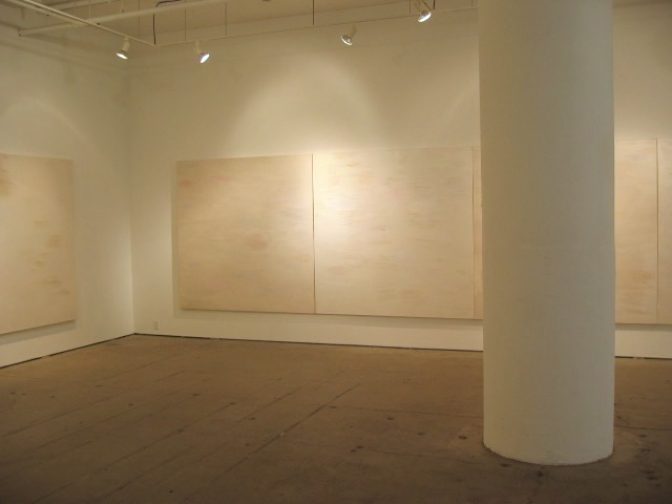
Demons • The Light
Installation view

Demons • The Light
Installation view

Demon: Beginning, 2000
Color pencil and metallic acrylic on onion skin paper
18 x 24 in.

Demon I, 2000
Color pencil and metallic acrylic on onion skin paper
18 x 24 in.

Demon Disintegration I, 2000
Color pencil and metallic acrylic on onion skin paper
18 x 24 in.

Demon: Horus I, 2000
Metallic acrylic on paper
18 x 24 in.

Demon: Horus II, 2000
Metallic acrylic on paper
18 x 24 in.
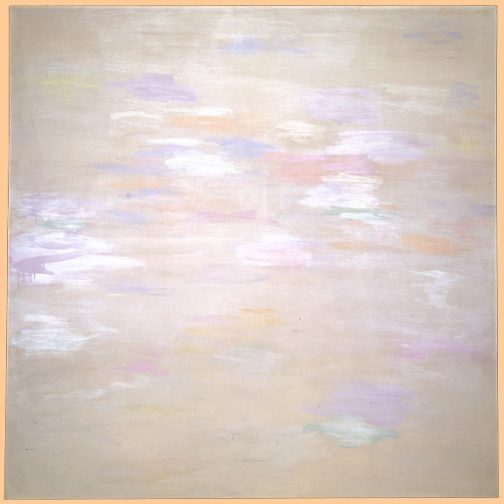
Landscape of the sky: September, 2002
Acrylic on canvas
72 x 72 in.
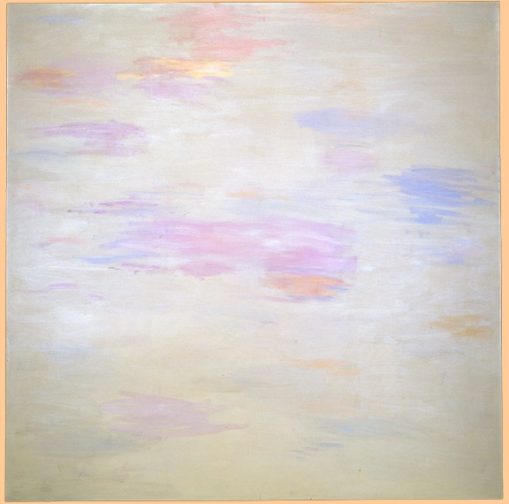
Landscape of the sky: June, 2002
Acrylic on canvas
72 x 72 in.

Landscape of the sky: August, 2001
Acrylic on canvas
72 x 72 in.

ZONE:Chelsea Center for the Arts is proud to announce DEMONS•THE LIGHT, new work by Ruth Kligman. Recently, Kligman’s paintings have gazed back to the quiet of a time before she was born—the moment when one of the seeds of American painting’s triumph began to germinate in a cultivated garden in France: Monet’s explorations of vision itself, his dissection of shape, figure, ground, and color. His monumental Water Lilieslaid a solid foundation for modern painting by atomizing nature and making the plane on which paint was brushed, layered, scumbled, and dragged into an experience that fast lost any narrative quality, becoming one of the sensations defining the modern world. The interlocking palimpsests of experience that Monet conjured from the water are reflected in the flecks of color and shifting shades that make up the ethereal atmosphere of Kligman’s landscapes of the sky.
But Kligman’s spiritual icons of the 1980’s and her more recent explorations of enveloping light have alternated with those demons that first loomed up in the 1960’s, drawn on onion skin with colored pencils and metallic pigments. The end of the millennium saw a resurgence of figurative expressionism across the art world; Kligman’s came from a place of re-examined tragedy. Like so many of her peers during the anxious 1950’s (which, as today, found New York City pegged on the bull’s-eye of a war between ideologies), Kligman had been in psychoanalysis—her Monster series seems to have sprung from an unconscious that was never fully allowed to rest. Monster: Horus and Monster: Disintegration are direct channels back to the automatic drawing and primal Jungian imagery that freed up the New York School generation; Kligman’s works carry on this tradition but take it to a place of her own making. In Demons, similar compositions begin with rounded, swirling layers shot through with jagged forms, then transmute into recognizably demonic visages before melting into squalls of orange, blue, and black. Kligman uses long, unbroken color-pencil outlines to define these strange entities and then energizes the overlapping skeins with metallic flashes of paint. The Horus series engages the viewer through broad areas of color that alternately suppress or yield to the writhing black, skeletal frameworks underneath; these are works of tense beauty.
The American century of art has had its share of glories and demons, and throughout, Ruth Kligman has been its abiding witness.
Ruth Kligman
DEMONS • THE LIGHT
January 20 – March 25, 2005
Opening Reception
6-8PM, Thursday January 20, 2005
A room of minimalist water lilies in lip gloss muted colors, industrial cosmetics contemporary feel, very spare, hardly there, muted colors, slight sheen, five foot square canvases end to end and on, a quiet contemplation, ephemeral, lurking. They are not water lilies. They are light. Abstract markings. Nudges. The least mark applied with extreme presencing by a master in command of her medium and taking the space for an entirely cosmic ride. One hears chords in the distance not quite dissonant and haunting. The experience in the room grows with time. The Rothko chapel in Houston has such an effect of the powerful ethereal.
But then the drawings are just the opposite. Dragons. Demonic scribbles that grows even more dynamic through her abstracting of these emerging tail cracking fire breathing enchanting monsters. Well they are in another room in the gallery, just as we keep our shadow side on the right side of the neo cortex of the brain. But these demon drawings are compelling, aggressive, raging marking, expressionist. Antonin Artaud drew a comparable series of automatist ravings shown at the Met a few years back. THEN WE RETURN TO THE HUGE MINIMAL CONTEMPLATIONS AND THE MINIMAL MARKING HAS JUST A HINT OF A DRAGONS TAIL FLICKERING THROUGH THE MIST. AHA. The hidden tension in these very spare works is now palpable. I am reminded of Barnet Newman crosses buried under the very minimal paint.
Ruth Kligman is at the top of her game as a painter. An artist with a fabulous history that is just surfacing into rewriting, as feminist theory evolves to dispel the onus on the mistress, making her a person and a painter in her own right. It is the right time to place Ruth Kligman properly in art history. She is no longer the art student among art giants, the beauty seen as the muse who launched a thousand abstract expressionist paintings, and psychotherapists now grasp that the new girl didn’t wreck the marriage in the first place it was more complex than that. Indeed one has to marvel that both Pollock and deKooning found her so conversational for years on end. What did they see? It is astonishing that men are never implicated in bedtime stories only women, ever. What mistress or kept man has had this reflected on his status as an artist I can’t think of one. Camille Claude only emerged as the sculptor rival of Rodin out of the shadow of master? A hundred years later? It is an epic we speak of, that the culture is now looking. Looking at art. Seeing context and history but really looking. Without dismissing offhand the work of women. Did this happen? Consult Gorilla Girls statistics for the gory facts.
Ruth Kligman is one of the towers of abstract expressionism and when this is outed many historians and critics will suddenly come forward with oh I always suspected, after years of hesitation to break from the dark hand. I like very much that she is painting from her self. Rapturous. Engaged. Moody and blooded and moaning and singing with the gods. Postmodernism has no idea how to approach this phenomenon. A lucky fool. A painter invoking the cosmic rain come donor, there was another painter who danced the cosmic rain come down. Jackson Pollock. When I asked Clem Greenberg what he felt about the spiritual in Pollock work, he stopped and snorted ineffable, – we don’t discuss that. Now we can discuss that.
Barnaby Ruhe, PhD, Senior Editor, Art/World, professor of art NYU, Artist/lecturer MoMA
The arc of Ruth Kligman’s life is reflected in the half-century evolution of her art, which spans the moment Irving Sandler christened “The Triumph of American Painting” and the myriad styles that coexist today. Mentored by Willem de Kooning in the late 1950s, Kligman’s early large-scale compositions are a strong opening act from a woman painting in the macho arena of abstract expressionism, conveying both the movement’s brio and its poignancy. The ambitious swagger of the era can be felt in the slashing reds and blacks that speed across an eight-foot canvas titled The Bullring; its emotions suffuse Broken Cosmos, where sullied whites and bruised magentas entwine sandy ochres, echoing the doubt and struggle of the generation of artists who broke the ice and brought forth an American art that finally elevated the New World to the firmament of the Old.
Rather than looking toward the figures underpinning much of de Kooning’s work, Kligman’s bold abstractions moved into the wide-open spaces of color-field painting. Throughout the 1960s her work retained its broad scale while the contrast between colors deepened, until finally they were stripped down to emphatic black and white contours pushing against the classic rectangular format. The Two of the Both of Us plays with curves jammed into right-angled corners or pressed against the straight edges of the canvas, like two lovers confined to a narrow, rigid bed. Following these, Kligman began to shape her canvases into totems of color, as in Coney Island Baby, where an orange oval (an egg?) provides the weight that balances a thrusting nine-foot chevron of blue.
There is a hint of darkness underlying this period, something welling up from underneath. In Birth (Early Monster), a 7’ x 8’ oil, an organic shape, like the lithe cross-section of a pelvis, has been brushed onto the canvas, heavy black outlines constraining muted, variegated grays. The compressed shapes railing against the edges of her canvases were holding something at bay.
Kligman, of course, had an affair with Jackson Pollock and was with him the night he died. It was Pollock, as de Kooning stressed, who “broke the ice” for all the painters who came after by breaking contact with the canvas—by pouring and dripping paint in exquisite arabesques of color that delicately traced the movements of his body. Kligman recalled, as own her work began to mature a few years later, “The expression became alive . . . a frenzy yet deliberate . . . the abyss of the unknown, jumping off the edge . . . Abstract Expressionism . . . when it worked it was an epiphany.”
The luminosity of fluid silver radiator paint—given a rosy flush through its mingling with a passionate skein of red that unveils a black figure—floods the painting Pollock made for Kligman. That hopeful glow colored her youth, and it reverberates in the luminous metallic paintings and works on paper she created in later decades. In the 1980s and ’90s, Kligman’s faith in art inspired reflective (both figuratively and literally) compositions incorporating the image of the cross, harking back to Byzantine icons whose precious metals foreshadowed the awaiting heavenly paradise. Monolith, Silver Cross, and Turquoise Cross bring out subtleties at the most basic intersection of light and surface.
Recently, Kligman’s paintings have gazed back to the quiet of a time before she was born—the moment when one of the seeds of American painting’s triumph began to germinate in a cultivated garden in France: Monet’s explorations of vision itself, his dissection of shape, figure, ground, and color. His monumental Water Lilieslaid a solid foundation for modern painting by atomizing nature and making the plane on which paint was brushed, layered, scumbled, and dragged into an experience that fast lost any narrative quality, becoming one of the sensations defining the modern world. The interlocking palimpsests of experience that Monet conjured from the water are reflected in the flecks of color and shifting shades that make up the ethereal atmosphere of Kligman’s landscapes of the sky.
But Kligman’s spiritual icons of the 1980’s and her more recent explorations of enveloping light have alternated with those demons that first loomed up in the 1960’s, drawn on onion skin with colored pencils and metallic pigments. The end of the millennium saw a resurgence of figurative expressionism across the art world; Kligman’s came from a place of re-examined tragedy. Like so many of her peers during the anxious 1950’s (which, as today, found New York City pegged on the bull’s-eye of a war between ideologies), Kligman had been in psychoanalysis—her Monster series seems to have sprung from an unconscious that was never fully allowed to rest. Monster: Horus and Monster: Disintegration are direct channels back to the automatic drawing and primal Jungian imagery that freed up the New York School generation; Kligman’s works carry on this tradition but take it to a place of her own making. In Demons, for example, similar compositions begin with rounded, swirling layers shot through with jagged forms, then transmute into recognizably demonic visages before melting into squalls of orange, blue, and black. Kligman uses long, unbroken color-pencil outlines to define these strange entities and then energizes the overlapping skeins with metallic flashes of paint. The Horus series engages the viewer through broad areas of color that alternately suppress or yield to the writhing black, skeletal frameworks underneath; these are works of tense beauty.
The American century of art has had its share of glories and demons, and throughout, Ruth Kligman has been its abiding witness.
R.C. Baker has exhibited his artwork at the Drawing Center, the Center for Book Arts, White Columns, and other venues in and around New York City; his writing has appeared in The New York Times, the Village Voice, the Performing Arts Journal, and other publications.
Ruth Kligman’s new work DEMONS and THE LIGHT is being shown at the ZONE 601 W 26thSt. Suite 302. Kligman’s art has a quiet power. Her art is not demanding attention, nor is there an attempt to convince a viewer of its worth. Her off-handed approach to art making, allows for an innocent and unpredictable range of expression. A tangled mass of colored pencil lines on onion-skin-paper has a completely unexpected material presence that is defined by the artist’s hand. In a careful balance of physical marking and emerging imagery, the presence of a ‘demon’ as a bundle of co-existing perspectives, defines itself in a viewer’s imagination. Images of demons become objects of sheer beauty. The ‘Demon’ drawings define a format for automatic image creation that allows for the freedom of expression that is essential to the uncensored emotive impact that emerges from each piece. This art lives in the ‘zone’ where the abstract expressionists left the illustrative shackles of Surrealism and defines the ‘surrealist expression’ as a state of mind to be experienced directly.
The Light begins with a group of small paintings on paper that Kligman calls the Cosmic Series. In these heavily painted surfaces, brush strokes are played down and give way to a massing of metallic paint that seems to smooth and polish a surface. But what is it? It does not depict anything. It reflects light casually. It seems like an unfamiliar piece of material. It is an object that glows. It holds light, shines; it maintains its strangeness. It refuses to give in to easy definition. This is not Neo Geo or a return to minimalism. It is a vision of painting construction that maximizes intuitive freedom within defined boundaries. The art making is held in check and freed simultaneously.
A third group of paintings in this show is influenced by the Cosmic Series. This time the painting is on canvas and large scale. Six ft. square canvases are butted against one another to form architectural installations. One wall has three canvases on it. The adjacent wall has five. The surfaces are built by scumbled, slashed and layered off-whites and subtle metallic paints that change color, like an oil slick, as the viewer walks by them. In the paper pieces, the strokes are barely distinguishable from their job of shining the paper surface. In the canvases, the brushwork is purposefully exposed, thereby creating a landscape arrangement to the marking. The painterly application of the paint in this series (Landscapes Of The Sky) is more familiar as painting, making the paper works ever stranger.
David Hatchett
RUTH KLIGMAN
EDUCATION:
Studied painting and Art History at the New School for Social Research, New York University and Yale. Studied with Larry Rivers, Gregorio Prestopino, Abraham Rattner, Reginald Marsh and Willem De Kooning.
SELECTED EXHIBITIONS:
SOLO EXHIBITIONS
2005 “DEMONS • THE LIGHT”, ZONE: Chelsea Center for the Arts, New York
1988 New York Studio Show, sponsored by Sur Rodney Sur
1987 Otis Gallery, London, England
1986 M. Donahue Gallery, New York, New York
1984 “Pier Show”, Brooklyn, New York
1983 Pier 34, New York, New York
P.S 1, New York, New York
1966 Ivan Spence Gallery, Ibiza, Spain
1964 Gallery International, New York, New York
1962 Thibaut Gallery, New York, New York
1959 March Gallery, New York, New York
Tangier Gallery, New York, New York
GROUP EXHIBITIONS
1989-90 Spencer Throckmorton Gallery, Santa Fe, New Mexico
1987 Wessel O’Connor Gallery, Rome, Italy
Christies Gallery, London, England
369 Gallery, Edinburgh, Scotland
Richard DeMarco Gallery, Edinburgh, Scotland
1986 Minneapolis Museum of Art, Minneapolis, Minnesota
1985 Kamikazi Gallery, New York, New York
Neo Persona Gallery, New York, New York
1984 Shuttle Gallery, New York, New York
1967 Museum of Modern Art, New York, New York
1958 Martha Jackson Gallery, New York, New York
Categories: exhibitions
Tags: Ruth Kligman
JOHN CAGE: Watercolors, Selected Drawings and Prints

River Rocks and Smoke 4/11/90, 1990
Water color on paper prepared with smoke
28 x 42 in. (70 x 101 cm)

New River Watercolor, SeriesIV, 1988
Watercolor on paper
26 x 40 in.

New River Watercolor, SeriesII, 1988
Watercolor on paper
26 x 40 in.

River Rocks and Smoke, 4/11/90, 1990
Water color on paper prepared with smoke
27 x 40 in.
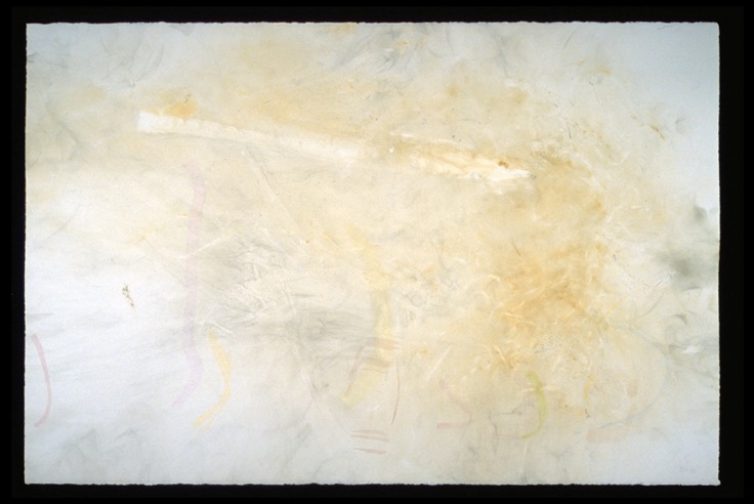
River Rocks and Smoke, 4/12/90, 1990
Water color on paper prepared with smoke
27 x 40 in.
ZONE: Chelsea Center for the Arts, presents its second exhibition in 2004 of visual art works by the late avant-garde composer, writer, artist and philosopher John Cage (1912-1992).
John Cage: Watercolors, Selected Drawings and Prints,* articulates the relationship of Cage’s watercolor paintings to his important involvement with printmaking, during which his fourteen year-long (1978 – 1992) experience at Crown Point Press transformed the traditional discipline of etching as surely as he had reinvented our idea of music thirty years earlier. His late-career watercolor paintings were created at the Mountain Lake Workshop in the rural Appalachian Mountains of Virginia between 1983 and 1990. They demonstrate, like his graphic works, a profound sense of beauty not usually associated with Cage’s dismissal of conventional aesthetics.
The watercolors shown here reveal the dynamic interaction with his graphic art works (mostly unique images), including the Ryoanji drawings that occupied his attention for eleven years. This exhibition offers an essential visual component to complement Cage’s lifelong achievement as America’s foremost avant-garde composer and artist, and highlights his role as the principal mediator of the influence of Asian culture and philosophy on his generation and those to follow. Cage’s visual art, like his writing, brings an even wider audience to his uniquely pioneering work and contributes to a broader understanding of his strategic use of “chance operations” in his music, writing, printmaking and painting as a way to redirect our pre-conceived and authoritarian attitudes toward the arts.
* Guest-curated by Ray Kass, founder and director of the Mountain Lake Workshop, in which John Cage produced his watercolor paintings between 1983 and 1990
JOHN CAGE: Watercolors, Selected Drawings and Prints
November 18 – December 18, 2004
Opening Reception
6-8PM, Thursday November 18, 2004
John Cage: Watercolors, Selected Drawings and Prints
Ray Kass, Guest Curator
Ray Kass is an artist and the founder and director of the Mountain Lake Workshop of the Virginia Tech Foundation, where John Cage produced his watercolor paintings between 1983 and 1990. He is Professor Emeritus of Art at Virginia Polytechnic Institute and State University in Blacksburg, Virgina.
I became aware of John Cage’s visual artwork and printmaking activities at Crown Point Press when I had the opportunity to interview him in 1980.1
During the course of our visit, Cage showed me an example of the work he was involved with at Crown Point, an etching entitled “On The Surface” (1980 – 1982), and some of the materials employed in the process (cut up copper etching plates). Cage described how he had used “chance operations” with the aid of a computer program derived from the method of random access of the ancient Chinese book of wisdom, the I–Ching, in making the complex print. He also described an even more complicated procedure for another related etching, also still in progress, entitled “Changes and Disappearances” (1979-82), and that used “chance” to incorporate an even more various array of imagery.2It occurred to me that his etchings had an extraordinary correspondence to the methods he utilized in composing his music – and that they were visual counterparts of sorts, related in a manner that one might not have expected (i.e. Schoenberg’s watercolors, for instance, don’t seem directly related to his composing anymore than Victor Hugo’s ink drawings and gouaches appear directly related to his novels). But the connection between Cage’s use of “chance” methodology in his various kinds of work (composing, writing, installation & performance art, & now printmaking) made sense in a way that awakened me to the great scope of his work.
In subsequent visits with Cage over the next three years he continued to show me examples of the etchings that he was working on at Crown Point, including a series entitled Where R = Ryoanji (1983), and a new group of related drawings. The Ryoanji etchings consist of patterns of circular overlapping lines incised with a sharp dry point etching tool around stones placed by Cage’s chance operations on a copper plate. The Ryoanji drawings utilized the same stones, but they are drawn around with pencils and are basically simpler in execution than the prints; Cage worked on them at home intermittently for the rest of his life. He commented to his friend and agent, Margaret Roeder, that he considered the Ryoanji drawings as “ a form of meditation”.3
Before I saw the Ryoanji drawings, I had never sensed a vital relationship between the tradition of drawing and that of painting and any of Cage’s earlier graphic arts; in contrast, those works seemed insistently unconventional in their demonstration of randomly acquired effects. Despite the fact that Cage had rendered the Ryoanji drawings in an unselfconscious, almost automatic way intended to avoid any “personal” stylistic manner, these works exhibit an implicit quality of hand gesture, however randomly acquired, and associated with the formal conventions of drawing. I asked Cage whether, since his early experiences with painting in the late ‘20s and early ‘30s, he had ever again thought seriously about painting; he said he had really not had time to consider it.
*
In spring 1983 I invited John Cage to direct a mycological foray (mushroom hunt) at Mountain Lake and to give a gallery talk at the opening of an exhibition of his prints and drawings that I had organized at nearby Virginia Polytechnic Institute and State University. During the several days of the 1983 workshop there were periods of free time to explore the mountains and rivers of Appalachia. We visited Ripplemead, a secluded place along the New River where the river stones are extraordinary. Cage loved the site and spent much of the afternoon enthusiastically selecting specimens of the smooth river stones. Many of the stones he admired were significantly larger than those used for the Ryoanji drawings but most of them were portable. We both realized that the larger sizes of these rounded stones might suggest their use in an experiment related to that of the Ryoanji drawings, in which he could employ a wide variety of materials, particularly brushes and water media, rather than pencils. I commented that the Ryoanji drawings suggested the possibility of a painting experiment in watercolor that might use the rocks from the site on the New River. Without dismissing the idea, he indicated that he was too unfamiliar with the medium and materials to imagine how to undertake such work – and that he felt unable to organize the studio facilities that would be necessary. His response seemed to indicate that he was being realistic but not closed to such an idea. During the next few days I resolved to try to create an appropriate studio situation in which he could acquaint himself with watercolor materials, and to surprise him with it before his departure. I returned to the site with my students and gathered many of the larger stones.
At the conclusion of his visit in 1983 Cage visited my studio, where I showed him the “studio practice” I had prepared for him the night before. It included an ample floor space covered with soft particleboard, and the 60 or so river rocks gathered the previous day and now numbered and divided into general size groups of small, medium and large. I provided a large selection of watercolor brushes each numbered and arranged in groups according to type and size, a selection of different kinds of rag papers, a palette of about 26 colors, and additional tubes of paint and many various containers for mixing paint. After a brief demonstration of brushes and paint qualities, I encouraged him to “experiment” by painting around some stones on several “practice” sheets of bond paper, which he appeared to enjoy. Then Cage took out his computer generated pages of random numbers based on the I-Ching and began to create a program for a painting – which was executed in about an hour – and I drove him to the airport for his trip back to NYC.
*
The experiment in my studio in 1983, and his ongoing development of his etchings informed and inspired his watercolor painting experiences at the Mountain Lake Workshop in 1988, 1989, and 1990. Prior to his death in August 1992, he was planning to return to Mountain Lake to make new paintings in the following October. In late 1989 I had shown Cage some examples of how the invisible divisions (or panels) that he often incorporated into his watercolors (and his composing of music) might become visible yet subtle elements of future painting experiments – his curiosity was engaged by this possibility. I believe that had he returned to the Mountain Lake Workshop in 1992, his watercolors might have expressed some correspondence with the soft geometric appearance of one of his final series of etchings at Crown Point Press, HV2 (1992).
The exhibition, John Cage: Watercolors, Selected Drawings and Prints, articulates the relationship of Cage’s watercolor paintings to his important involvement with printmaking. I think that Cage’s fourteen year-long (1978 – 1992) experience at Crown Point Press transformed our idea of the traditional discipline of etching as surely as he had reinvented our idea of music thirty years earlier. His late-career watercolor paintings demonstrate, like his graphic works, a profound sense of beauty not usually associated with Cage’s dismissal of conventional aesthetics. An intrinsic sense of beauty, in fact, is at the center of the experience that one may have in encountering his work. The watercolors shown here reveal the dynamic interaction with his graphic art works (mostly unique images) after 1988, in works such as The Missing Stone, 9 Stones, and 10 Stones– all produced 1989.
This exhibition offers an essential visual component to complement Cage’s lifelong achievement as America’s foremost avant-garde composer, and highlights his role as the principal mediator of the influence of Asian culture and philosophy on his generation and those to follow. Cage’s visual art, like his writing, brings an even wider audience to his uniquely pioneering work and contributes to a broader understanding of his strategic use of “chance operations” in his music, writing, printmaking and painting as a way to redirect our pre-conceived and authoritarian attitudes toward art and life.
NOTES:
- My visit with Cage was to interview him about the Pacific Northwest painter and mystic, Morris Graves, with whom Cage had a long friendship, whose retrospective exhibition I was organizing for the Phillips Collection. Graves and Cage became close friends in Seattle during the late 1930’s when Cage took a position as percussionist at the innovative Cornish School of Art. Graves was a colorful and pivotal figure among a small and adventurous group of young Seattle artists and involved Cage in his famous Dada antics as well as introduced him to the Buddhist Temple in the Yessler district, Asian art, and aspects of the Native American culture. The Painter Mark Tobey taught at Cornish at that time, and also became a critical figure in Cage’s artistic development and befriended the 26 year-old Cage. Our conversation that morning was filled with discussion about his deep involvement with both Graves and Tobey at a formative time in his own artistic development – and how Tobey in particular related to aspects of his current experiments in visual art. Cage described how Tobey and his paintings had profoundly effected his “seeing” – his actual perception of the world. The Phillips Collection project resulted in his traveling retrospective in 1983-84 and my publication, Morris Graves, Vision of the Inner Eye, (New York: George Braziller, 1983).
- The computer program had been developed for him at Cornell University – in order to more easily allow him to randomly access the 64 Hexagram structure of the I-Ching without having to go through the process of throwing stones or sticks. Based on our conversations, it was my impression that Cage chose the system of random-number access of the I Ching, rather than the Rand Corporation system, or any other system of random numbers, as the basis of his own use of indeterminacy in his work, because it was the most ancient system of random numbers in the world – and he wanted to point to that in a gesture of cultural affirmation of its significance – as well as acknowledge the influence of Asian culture and art on world culture. After selecting the elements of the work – or making “choices”, Cage described making Changes and Disappearances from eight copper plates that had been cut into 66 various smaller pieces whose curved shapes were determined by dropping greased string from various heights onto the plates (as an homage to Marcel Duchamp’s earlier use of a similar strategy to create “lines”) and straight edges determined by cutting along lines between chance-determined quadrants, he described how three types of etching techniques might (according to chance) be applied to these pieces, as well as photographic images of drawings from Henry David Thoreau’s journals.
My (partial) descriptions of processes and materials involved in Cage’s etchings have been derived from Crown Point Press publications documenting Cage’s work at the press, particularly, John Cage – Etchings: 1978 – 1982(Crown Point Press, 1982) containing Paul Singdahlsen’s writing about On the Surface 1980 – 1982) and Lilah Toland’s notes on Changes and Disappearances(1979 – 1982), and also Kathan Brown’s book, John Cage, Visual Art: To Sober and Quiet the Mind(San Francisco: Crown Point Press, 2000) and her writing on Where R = Ryoanji(1983). Kathan Brown’s essays on John Cage have been particularly helpful to me.
- The Ryoanji etchings consist of patterns of circular, overlapping lines incised with a sharp dry point etching tool around stones placed by chance operations on a copper plate. the size of the prints and drawings as well as the number of stones (15) that he used for their execution are proportionate with the number of stones and the space in which they are arranged within the 360 square yards of raked gravel of the Ryoanji garden. The development of these etchings preceded Cage’s ongoing series of Ryoanji drawings; both the Ryoanji etchings and drawings were made approximately during the time that Cage’s was composing the music entitled Ryoanji(1983-84); although Cage described to author Joan Retallack how the music is different from the prints and drawings, (cited in Kathan Brown, John Cage: Visual Art to To SOBER and QUIET the MIND, (San Francisco: Crown Point Pres, 2000) 96), all three creations are inspired by the Zen-style Ryoanji garden in Kyoto, Japan.
ZONE: Chelsea Center for the Arts and Guest Curator Ray Kass would like to thank Laura Kuhn, Director of the John Cage Trust, Kathan Brown, Director of the Crown Point Press, and Margarete Roeder of the Margarete Roeder Gallery.
Related:
Categories: exhibitions
Tags: John Cage
JOHN CAGE: Works on paper

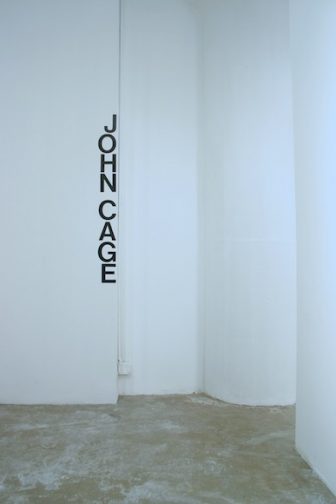
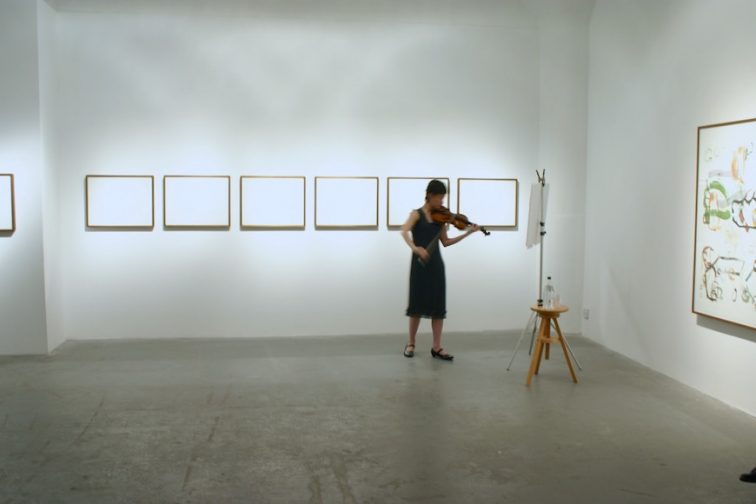
Opening, Talks and Readings

Opening, Talks and Readings

Opening, Talks and Readings
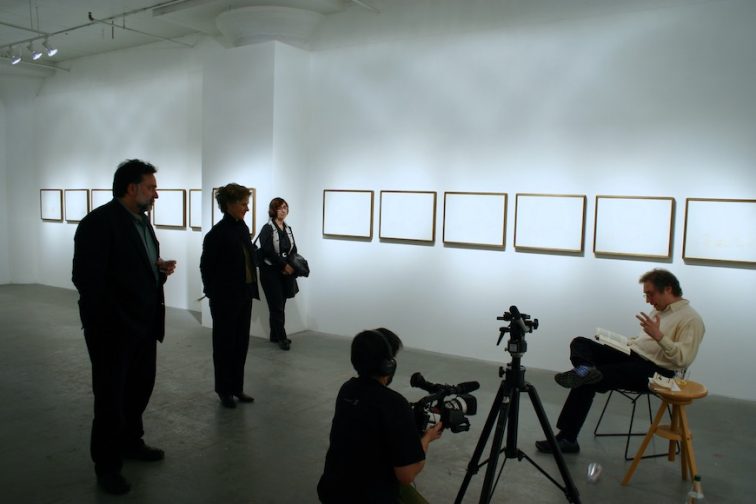
Opening, Talks and Readings

Opening, Talks and Readings
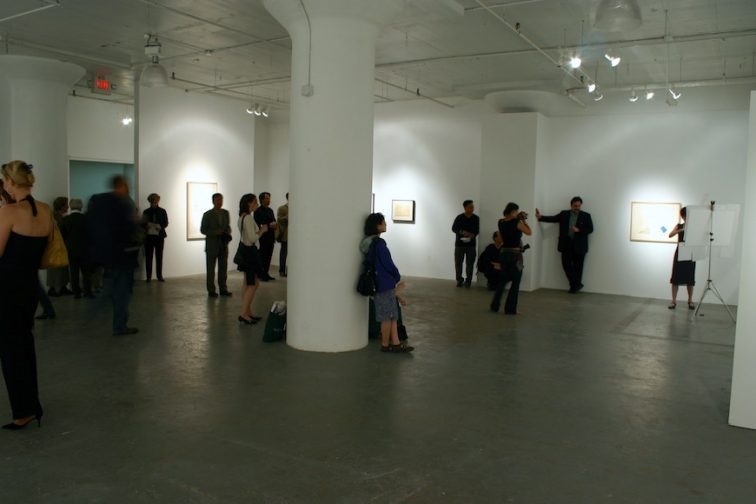
Opening, Talks and Readings

Opening, Talks and Readings

Opening, Talks and Readings
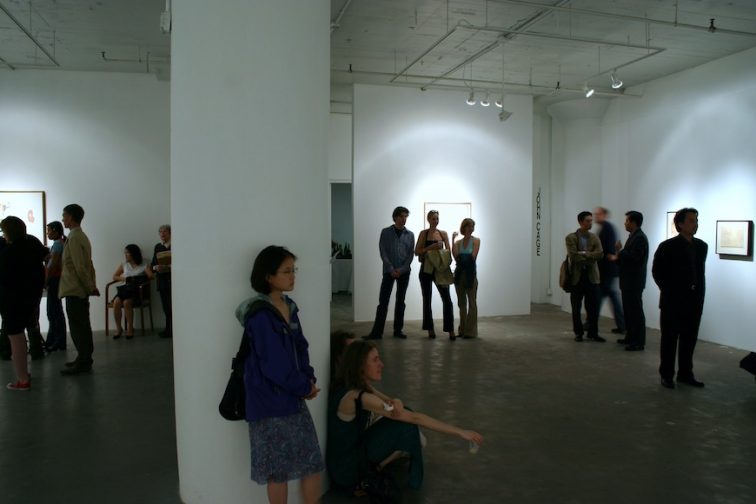
Opening, Talks and Readings
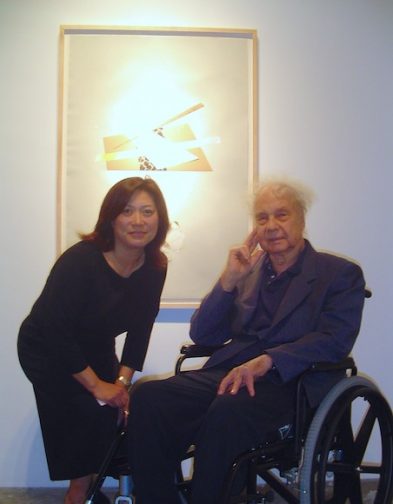

Opening, Talks and Readings

Invitation card
John Cage, best known as one of the twentieth-century’s most original musicians and aesthetic philosophers, was also a highly original and accomplished artist who made a unique contribution to the history of printmaking. ZONE:Chelsea is proud to present 25 of his works on paper, along with a program of events placing his work in its multidisciplinary context. Included in the show are the very rarely exhibited complete sets of Ryoku (1985, thirteen color drypoints), and Where R= Ryoanji (1983, four drypoints). Also on view will be Where There Is Where There – Urban Landscape (1987-89), which exemplifies Cage’s technically innovative and conceptually rich method. Holding twelve large etching plates over asphaltum treated flames, the artist inked each plate with one of seventeen earth colors. The printing order of the plates was determined by chance operations, which Cage – like his longtime collaborator, the choreographer Merce Cunningham – believed freed the imagination.
Cage produced thirty-three titles with Crown Point Press, not only casting the I-Ching to determine moves, but also pushing etching and printmaking techniques to the limit by, for example, setting fire to the press or scorching the paper with hot tea kettles. One work that emerged from the fire process is the epic-scale 75 Stones (1989) outlining the variously sized stones scattered across the paper. Cage worked at the press every year from 1978 until his death.
John Cage was a polymath with an individualistic take on Zen traditions and ways of approaching the art of living. Appropriately, there are a number of events scheduled to complement the exhibition during the May 7 opening reception. Illuminating Cage’s working process, Master Printer Peter Pettengill will talk about the rock-outlining process of the Ryoku prints. Deborra Stewart-Pettengill will share anecdotes on macrobiotic pickle-making (one of Cage’s passions). We are honored to have Merce Cunningham reading some of Cage’s work to accompany rarely performed live readings of Cage’s text on the artists Robert Rauschenberg, Jasper Johns, Nam June Paik, and Marcel Duchamp, which will be read throughout the evening by award winning poet Martine Bellen, internationally known composer Dr. Mathew Greenbaum, Chairman of ZONE:chelsea Center for the Arts William Park, and performer Cathy Richards. Violinist Miranda Cuckson will bookend the evening with selections by Cage on the violin.
JOHN CAGE: Works on paper
May 7 – June 18, 2004
Opening Reception, Talks and Readings
6-8PM, May 7, 2004
Related:
Categories: exhibitions
Tags: John Cage
PAT STEIR: Works on paper

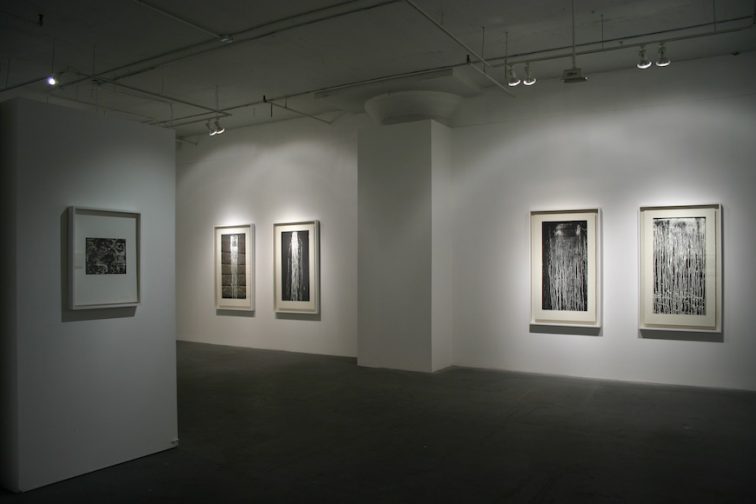
Installation view
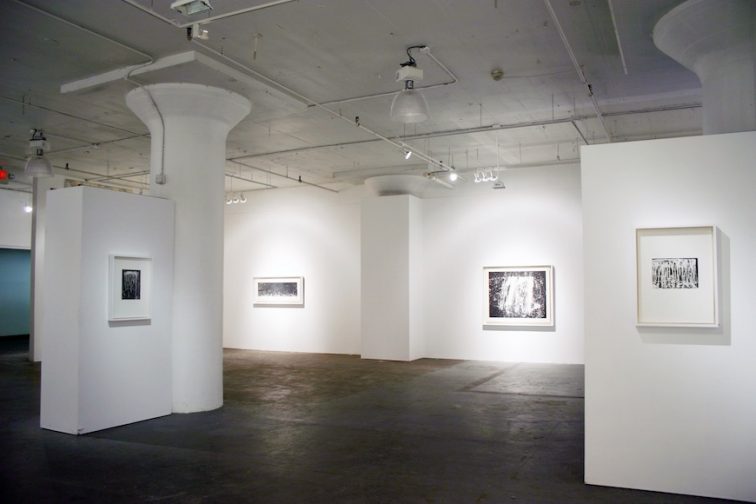
Installation view

Installation view

Installation view

Installation view

Installation view

Installation view
In these two dozen artist’s proof prints, on view at ZONE:chelsea March 13 – April 24, 2004, Pat Steir explores a signature motif, the waterfall that provides a central dynamic element in landscape. Here highly personal development of this theme places her in an art historical continuum that includes Romanticism and Abstract Expressionism, while resonating with the millennia-long tradition of Asian art. She goes beyond reference to nature as a subject and locus for negotiations between abstraction and representation to engage the idea of artmaking as process.
The act of creation is a performance, and the work perpetuates the gestural immediacy of the artist’s hand. In a series of celebrated paintings, Steir emphasized the liquid nature of the medium, imitation the process with a sudden brush and swiping to channel the flow of released paint as it dripped down the canvas.
Steir’s work as a printmaker displays the same intuitive sensitivity to the way mediums behave. The spit bite aquatints in this exhibition, executed at the Crown Point Press, testify to the primordial power of the artist’s hand, vividly illustrating one of Steir’s key beliefs: “the one mark is for me a symbol. The straight line is the symbol of drawing, all drawing and painting, because it is all just a matter of how the lines are arranged.”
The way the lines are arranged in the print series Long Vertical Falls conveys, paradoxically, both vertigo and meditative equilibrium. Extending the legacy of the Abstract Expressionist drip-and-splatter aesthetic, these compositions also evoke the scroll paintings of Asian art. Steir’s centrally placed motif, running the height of the images, suggests a dramatic sense of scale – even grandeur – in a relatively intimate space. There are no mountains, bridges or diminutive scholars depicted; the act of contemplating nature has been re-positioned outside the picture frame. The movement of the artist’s hand, working both with and against the force of gravity, is central to Steir’s idiom. Roughly parallel lines coalesce into a recognizable natural form, yet with their wayward vitality they retain the artist’s mark and celebrate the physicality of the materials she uses.
PAT STEIR: Works on paper
March 13 – April 24, 2004
Opening reception
6-8PM, March 12, 2004
Categories: exhibitions
Tags: Pat Steir
R.C. BAKER: “…and Nixon’s coming” | the draft

Installation view

Installation view

Installation view
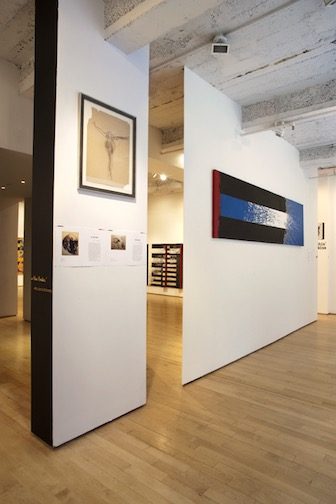
Installation view

Installation view

Installation view

Installation view

Installation view
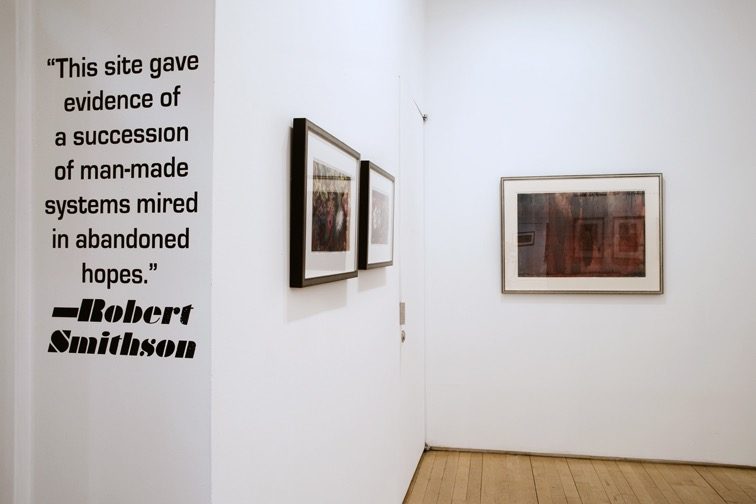
Installation view

Installation view

Installation view
ZONE: CONTEMPORARY ART is pleased to present “ . . . and Nixon’s coming” | the draft, R.C. Baker’s first solo exhibition with the gallery.
“. . . and Nixon’s coming” combines art, fiction, and design to create a multifaceted narrative that arcs from the Moscow show trials of 1937 to President Nixon’s resignation, in 1974. Divided into four sections, the work views the turbulent artistic and social ferment of the mid-20th century through the experiences of the story’s main character, Kirby Holland, and through his artwork, including academic drawings and studies after the old masters, comic-book illustrations, and amalgams of Abstract Expressionism, Pop, and graphics. Whether figurative or abstract, none of the art functions as illustration; rather, the images create a parallel track to the text. Kirby progresses from earnest art student to member of an army unit charged with repatriating Nazi loot to comic-book illustrator caught up in McCarthy-era witch hunts to determined and eclectic painter at a time—the 1970s—when painting was viewed by many as irrelevant, if not completely dead.
The book “ . . . and Nixon’s coming” is a work in progress, created with varying fonts, layouts, and graphics—a literary/historical/graphic-novel/art-catalogue hybrid. The images for Part i, “The Fractured Century,” set in the years 1937–47, include still lifes, figure drawings, and early abstractions. Part ii (“Smashin’ Pumpkins,” 1952–55) features black-and-white action paintings, comic-book pages, and large-scale collisions of the two. Layered abstractions and reconceptualized Pop portraits appear in Part iii, “Incoming” (1964–68); dense collages and painterly graphics characterize Part iv, “What? My Lai?” (1972–74). All of the paintings, drawings, and prints were actually created between 1979 and 2009, with additional work planned as the book progresses.
On Saturday, April 18, at 1 pm, Mr. Baker will read from “ … and Nixon’s coming” and discuss the work in the exhibition as well as the relationship between criticism and fiction.
R.C. Baker’s articles and essays have appeared in TheVillage Voice, Performing Arts Journal,The New York Times,and other publications, and his paintings, drawings, and artist’s books have been exhibited at numerous venues in New York City, including the Drawing Center, White Columns, and the Center for Book Arts. Mr. Baker is the recipient of a New York Foundation for the Arts Painting Fellowship and has taken part in numerous panels discussing subjects ranging from “The Future of the Graphic Novel” to last year’s Whitney Biennial. He most recently appeared as a talking head for the Ovation channel’s documentary Jeff Koons: Beyond Heaven.
A solo exhibition by R.C. Baker
April 2 – May 30, 2009
Opening reception
6-8PM, Thursday, April 2, 2009
Artist’s Talk
1PM, Saturday April 18, 2009
Related:

The Brooklyn Rail reviews RC Baker’s solo exhibition, “…and Nixon’s coming” the draft
Categories: exhibitions
Tags: RC Baker


